
Sailboat vs Powerboat - Which is Right for You?

Last Updated by
Daniel Wade
June 15, 2022
Sailboats and powerboats both have unique advantages and disadvantages. You have to weigh the pros and cons of each to know which boat is right for you.
Sailboats require a more hands-on approach, which many people prefer. Yet, powerboats have less maintenance and more speed. Which kind of boat you choose depends entirely on what kind of experience you want to have.
Powerboats are easier to operate, and they require a little experience. But, they are costly to keep running and you’re reliant on how much fuel you brought on board.
On the other hand, sailboats require training and experience. But, sailing is the purer boating experience, and many people prefer it because it offers them the freedom to travel anywhere in the world with only the wind.
Table of contents

Should You Get a Powerboat?
Powerboats are fast, fun, and spacious. For people who just want to get out on the water, without much setup, motorboats provide that easy access.
Depending on the boat, there are tons of family activities to do, such as tubing, waterskiing, wakeboarding, or fishing. Or, you can just enjoy a cruise around the waterways.
Powerboat Pros
Powerboats typically have more deck space because there isn’t as much hardware taking up space as in a sailboat. So, you can take out more people at a time, which is a pro for people with big families or who plan on taking many people out with them each time.
Often, the galley and cabin area has more space in a motorboat as well. People who plan on taking long off-shore fishing trips prefer motorboats because of the deck space for gear and people. Also, motorboats don’t have the same deep hull as a sailboat, so you can get into shallower waters if necessary.
If you’re new to boating, a powerboat might appeal to you more than a sailboat because there isn’t as much training involved in learning how to operate it. Sailboats take months (sometimes years) of experience to get confident with. With a motorboat, all you need is a GPS and a vessel license.
Also, to operate a motorboat, you’re only reliant on the sun shining. You don’t have to wait for wind conditions to be perfect. You can just get up and go whenever you feel like it. Unlike with sailing, where you are subject to changes in wind and tides.
Powerboat Cons
Even though powerboats are easier to operate and give you more space, they are more expensive to operate. You’re reliant on the engine to move, and you’ll likely use a lot of fuel each time you go out, which can quickly add up. Also, it’s less environmentally friendly than a sailboat, which uses minimal amounts of fuel.
The engines on powerboats are more expensive too. If for some reason you have to replace Or repair the engine on your boat, you can expect to pay a pretty penny. For that reason, it’s important to do regular check-ups and maintenance on your engine to keep it running smoothly.
The engine itself is also loud and smelly, which some people might say retracts from the experience of being out on the water. For people who get seasick especially, that smell doesn’t help.
Basically, with a powerboat, expect to pay more and have an experience that’s focused more on the water activity, rather than the joy of being on the water.
Should You Buy a Sailboat?
Sailing is one of the oldest methods of transportation, and that classic romantic feeling remains. With sailing, you have to pay attention to wind conditions, before you go out and as you’re on the water.
Sailboat Pros
Many people prefer sailing because it forces you to be in tune with the elements and the boat itself. Sailing is a very hands-on activity that requires training and practice to do effortlessly.
Because more effort goes into sailing, most people find it to be a rewarding experience that rejuvenates and refreshes the senses and the mind. You could compare operating a sailboat to doing yoga. All the pieces have to flow together, including the people on board.
Even small sailboats have trolling motors onboard. But, most sailors try to use the motor as little as possible and rely solely on the wind and tides. Not having a large engine saves you money on fuel and maintenance costs.
Sailing is much better for the environment than powerboats are. Sailing doesn't do any damage to the environment, as long as you stay off reefs and don’t allow trash to fall into the water. Motor usage is minimal, so you don’t contribute to the world’s fuel consumption as much. Many sailors pride themselves on being able to sail their boat without using the motor at all, even when it comes to docking.
Also, since sailboats rely on the wind, you can travel anywhere in the world if you want. There are countless accounts of people crossing oceans with only the wind in their sails.
Or, if sailing across the Atlantic isn’t for you, many people enjoy island hopping in the Caribbean for months at a time. If that appeals to you, you might be a sailor.
Unlike with a motorboat, you can go virtually anywhere on a sailboat with a bit of weather planning and manpower, no fuel necessary.
Sailing is a more satisfying experience and a quieter one as well. Since wind powers a sailboat, there’s no engine noise or smell to hinder your experience.
Some might say sailboats are for those people who are more adventurous at heart.
Sailboat Cons
Even though some people enjoy the hands-on aspect of sailing, it does require training. It’s dangerous to operate a sailboat on open water without proper knowledge of its workings.
Sailboats have a lot of moving parts and hardware. Many people grow up sailing and get their experience that way. But, if you aren’t someone who grew up sailing, you should consider a sailing class or even asking an experienced sailor to take you out and teach you what they know.
If you’re someone who doesn’t want to take the time to learn how to sail , it might not be the right boat for you.
Then, there’s the fact that you’re reliant on the right conditions for sailing. If there’s no wind or too much wind, your sailing experience won’t be as enjoyable or even possible. If you live somewhere that doesn’t have regularly good sailing conditions, that might prove to be a major con for you.
Or, if you don’t have a schedule that allows you to go sailing whenever the conditions are right (which could be in the middle of the week), you might not get as much sailing time out of your sailboat as you’d like.
There is no quick outing on a sailboat. It requires planning with the weather and tides, setting up the rigging and sails, and being at the mercy of the wind. So, if you don’t want your outing to take up most of the day, sailing might not be for you.
Because sailboats have deeper hulls, you have to be careful of shallow areas. It is possible to get stuck with a sailboat.
Also, many people choose to keep their sailboat in a slip at a marina because anything over 20’ is more difficult to transport and store. With a deck slip, you can keep the mast up and the rigging ready to go, so there’s less set up a time when you do want to go out.
So, if you’re in the market for a sailboat, make sure to check the cost of local dock slips as well and decide if that’s in your budget.
Because of the sails, mast, and rigging, you have less deck space with a sailboat. To get the deck space you desire, you’ll likely have to counter with a larger sailboat.
Finally, sailing is more of a commitment than a powerboat, but it’s a more rewarding experience that boating purists deem worth it.
Sailboat vs Powerboat: Which is Right for You?
There’s a lot to consider when it comes to deciding on a sailboat or a powerboat. Ultimately, it comes down to what kind of boating experience you’re looking for, and how much time you’re willing to commit to it.
Motorboats are a hobby, while sailboats are more of a lifestyle.
If you want to get out on the water without much fuss on choice weekends with your friends and family, a powerboat will get you out there. But, expect to pay high fuel prices and sacrifice some of the experience of being on the water.
On the other hand, if you’re looking for a way to get closer to nature, yourself, and possibly explore the world, a sailboat is the vessel for you. A sailboat requires more training to operate, more time to plan trips, and often you get fewer amenities with it.
Despite that, sailing is a purer boating experience that forces you to focus on the task at hand and the elements around you. If you plan to sail with your family or friends, it’ll be a bonding experience for everyone involved.
Related Articles
I've personally had thousands of questions about sailing and sailboats over the years. As I learn and experience sailing, and the community, I share the answers that work and make sense to me, here on Life of Sailing.
by this author
Most Recent

What Does "Sailing By The Lee" Mean?
October 3, 2023

The Best Sailing Schools And Programs: Reviews & Ratings
September 26, 2023
Important Legal Info
Lifeofsailing.com is a participant in the Amazon Services LLC Associates Program, an affiliate advertising program designed to provide a means for sites to earn advertising fees by advertising and linking to Amazon. This site also participates in other affiliate programs and is compensated for referring traffic and business to these companies.
Similar Posts

How To Choose The Right Sailing Instructor
August 16, 2023

Everything You Can Pull Behind A Boat
May 25, 2023

Cost To Sail Around The World
May 16, 2023
Popular Posts

Best Liveaboard Catamaran Sailboats
December 28, 2023

Can a Novice Sail Around the World?
Elizabeth O'Malley

4 Best Electric Outboard Motors

How Long Did It Take The Vikings To Sail To England?

10 Best Sailboat Brands (And Why)
December 20, 2023

7 Best Places To Liveaboard A Sailboat
Get the best sailing content.
Top Rated Posts
Lifeofsailing.com is a participant in the Amazon Services LLC Associates Program, an affiliate advertising program designed to provide a means for sites to earn advertising fees by advertising and linking to Amazon. This site also participates in other affiliate programs and is compensated for referring traffic and business to these companies. (866) 342-SAIL
© 2024 Life of Sailing Email: [email protected] Address: 11816 Inwood Rd #3024 Dallas, TX 75244 Disclaimer Privacy Policy

Sailboat vs. Motorsailer | How They Compare & How They Differ?

Sailing as a hobby is a fun, relaxing, and often invigorating experience. People from all backgrounds can enjoy setting sail and taking in the fresh humid air. If you’re just getting acquainted with the sailing world—or even if you’ve been around boats for years—there are tons of things to learn. There are many different types of sailboats, and there are various uses for each type. Many people consider sailboats vs. motorsailers and how they compare and differ. When making a purchase, you want to make sure you’re getting the best boat for your needs.
What are the differences between traditional sailboats and motorsailers? There are big differences in cruising when it comes to sailboats vs. motorsailers, but the main difference is that sailboats are powered by the force of the wind, while motorsailers use an engine to sail.
Read on to learn how sailboats and motorsailers compare, as well as some things they have in common.
Sailboats vs. Motorsailers: What’s the Difference and How Do You Choose?
People have been sailing on the water for centuries. Since their beginning, boats have been used for many different reasons, from trade to protection to sport! Depending on your personal preferences, you may choose either a pure sailboat or a motorsailer.
While a motorsailer is a type of sailboat, it still has many aspects that set it apart from the pure sailboat, specifically what makes the boat move forward in the water. Choosing which boat is best for you should be based on your preferences and skills when it comes to sailing. (And remember, you don’t have to get tied down to just one boat. Many sellers provide the option of renting boats for those who want to test the waters first. No pun intended. )
When you’re deciding to purchase either a traditional sailboat or a motorsailer, you must consider what your goals are with sailing and cruising. Asking yourself the following questions before you start shopping is a great way to narrow down your search:
- Are you a beginner in sailing?
- What is your budget?
- Do you plan on traveling long distances?
- Do you want to have passengers with you, or do you prefer to sail alone?
- Do you plan on living aboard the boat?
- What type of body of water do you plan on sailing?
- What do you plan on using your boat for?
Each boat comes with its own benefits and disadvantages. It’s up to you, the sea voyager, to do your research, learn about each type, talk to professionals, and decide which is best for you.
Fortunately for you, we put together this complete guide to learning about and purchasing these vessels. Continue reading to learn about some facts and features of each to get started on your journey.
Sailboats: How They Work and If They’re Right for You
When you close your eyes and think of sailboats, what do you see? You may think of peaceful, quiet afternoons on a breezy bay, cruising in the wind. However, over the years, these boats have advanced to become capable of so much more than their humble roots. Sailboats can race, go long distances—whatever you can dream of!
But what exactly are sailboats? Sailboats are small, personal vehicles that are propelled by sails smaller than sailing ships. They use the force of the wind to sail forward.
There are many different types of sailboats that range from small sailing dinghies to large, luxurious yachts over 200 feet long. The classification all depends on their size and purpose.
How Do Sailboats Work?
Sailboats don’t have to be complicated. They have a few common parts that each have their purpose when it comes to propelling the vessel. To put it simply, sailboats are powered and propelled by the wind.
Each common sailboat has the following components:
- The Hull is the shell of the boat that contains its internal components. It has a symmetrical shape that balances the boat and reduces the backward pull from its movement in the water.
- The Tiller is a piece that can be compared to a car’s steering wheel.
- If the tiller is the steering wheel, the Rudder is the boat’s “tire.”
- The Mainsail is the larger sail that takes in the bulk of the wind to propel the boat forward.
- The Mast is a long vertical pole.
- The Boom is a long pole that’s parallel to the deck. This can be rotated 360 degrees horizontally to give the mainsail as much wind as possible.
- The Jib is a smaller, triangular sail that adds power to the mainsail.
- The Keel is a slim plank that extends from the bottom of the hull. It provides balancing underwater that keeps the boat from tipping.
When the boom is pivoted perpendicular to the wind, the mainsail will puff outward. It’s pretty well-known about sailing that you want the wind at your back in order to give your boat the most force to move forward.
These types of boats mainly rely on ballast for stability, which can be 30-50% of the boat’s weight.
Exploring the Types of Sailboats
Your options are endless when it comes to the traditional sailboat. There are many different types of sailboats, which are all categorized by their components:
- Hull type: catamaran, monohull, trimaran
- Keel type: fin, wing, bilge, daggerboard, or centerboard
- Mast and sail configuration: sloop, fractional rig sloop, yawl, schooner, ketch, yawl, cutter, cat
Want to move fast? The speed a boat can reach will depend on its build and its size. Racing boats tend to be sleek, light, and slim. Large, bulky ships tend to cruise more slowly due to drag and friction.
Who Are Sailboats Good for?
Sailboats have a long history; in the past, they were used as early as Ancient Egyptian times. The Egyptians used sails to travel upstream against the Nile River’s current. They were also used to create international trade routes.
Today, people use them for many things, but most often for recreation. Cruising and racing are some of the most popular hobbies of sailboat owners. Small dinghies tend to be better for racing. There are even professional sailboat racing teams!
You can cruise a sailboat in a variety of bodies of water like lakes, rivers, canals, coastal waters, and, of course, oceans. Many people choose sailboats for quick daytime sailing or weekend getaways. Sail solo, or bring a crew of your friends aboard for a great time!
Pros and Cons of Using a Traditional Sailboat
As with anything using a traditional sailboat comes with its advantages and disadvantages. Here are a few you should consider:
- Over the years, advanced technology has allowed manufacturers to make sailboats more sturdy, but remain light at the same time. This allows them to move swiftly with little wind but remain durable cruise after cruise.
- Sailboats are a great option for people who want to learn the process of manual sailing.
- Because sailboats rely on environmental factors, you often have to wait for ideal weather and wind conditions before hitting the water. You need a calm patch of waves and ideal wind to have a good cruise.
- Next, sailboats don’t roll very much; they reach an angle of heel and pretty much remain there. The heel will depend on how much wind you get and how much sail you have. And the sail will depend on how hard you want to push the boat to get to your destination. This process will require some packing up, often more than what is required for cruising with a motorsailer.
When considering the cost of a sailboat, understand that it goes beyond simply the purchase price. You must also account for costs like insurance, dock fees, regular maintenance, upgrades, and more. Speak with a professional sailboat salesperson as you’re making your decision. Try to get the best recommendations for your budget and your needs.
Motorsailers: How They Work and If They’re Right for You
Motorsailers are a type of sailing vessel that is powered with an inboard engine in addition to its sails. Owners of this boat have the option to use the power of the engine or wind to the sails to move the boat.
These hybrid boats are great at aiding with propulsion backup and roll reduction. The added bonus is that you get to enjoy the fun of sailing, while also having the option to kick back and let the engine do its work if you want.
How Do Motorsailers Work?
The first version of the motorsailer came about after the invention of the steam engine. Back then, navies were wary about these new engines and instead relied on a large sailing rig as a backup for propelling their fighting ships. Unfortunately, many of these first powersailers were faulty and did not work well. Since then, we’ve made many advancements to the design and capabilities of the motorsailers we see on the water today.
Motorsailers can be equally powered by both the internal engine and the sails. These boats often have a large fixed propeller to aid in movement along the water.
Don’t confuse these boats with a powerboat. While they have a large engine like a powerboat, the motorsailer can still work well with wind alone. Many engines in boats are used as a backup, but the motorsailer’s engine was built to propel the boat forward with similar displacement speeds as traditional trawlers.
A cool feature of the motorsailer is its enclosed cockpit, also known as a doghouse. Some models may also come with a higher freeboard than pure sailboats. The inboard drive unit protrudes through the keel, which is sometimes more shallow than a vessel built purely for sailing.
Although many models of motorsailers are spacious and known for their luxury, much of the boat’s space is dedicated to fuel storage.
Exploring the Types of Motorsailers
The types of motorsailers vary. Many are built with luxury accommodations and are great options for living aboard. The size of motorsailers ranges from 35 feet or longer, up to 245 feet, often with two to three cabins. Motorsailers are a great option if you want to cruise overnight and sail in the day time.
Motorsailers come in a variety of types, which all depend on the ratio of sail propulsion to power. (These range from 30 percent sail/ 70 percent power up to 70 percent sail/ 30 percent power.)
Who Are Motorsailers Good for?
Motorsailers are great for long cruises because they are more comfortable, coming with a lot more space than traditional sailboats. They can be customized inside to be as welcoming as your home on land.
You can comfortably take them offshore in between ports or other anchorages fairly quickly. It all depends on the boat’s fuel tanks and its rate of consumption.
Once you get to know how to use motorsailers, you can get great sailing synergy. This can produce a net gain in speed over what would be possible by just using one method of propulsion. Three knots of fuel can get you seven to 10 knots of boat speed.
These types of boats are great for people who are trying to decide between a pure sailboat and a powerboat. If you can’t make that final decision, these boats are an ideal combination for indecisive boat-goers.
Pros and Cons of Using a Motorsailer
- The motorsailer is often more convenient for a lot of people than pure sailboats. It allows you to have those lazy days when you don’t feel like setting up your sails.
- These vessels can sit in flat water with minimal rolling. This minimizes the amount of packing up and strapping down for your decorations and personal kit. You just need to make sure you have ideal bilge keels or gyro-driven stabilizers.
- Motorsailers can tackle a wide range of weather and sea conditions without damage or discomfort. They’re able to keep up a decent speed even if there is little to no wind. They’re also pretty nimble with the sail alone under a decent breeze.
- This boat may be bulkier and heavier, which allows for more space for accommodations inside the boat.
- One disadvantage of the motorsailer is the heeling angle. The wide stern and heavy displacement isn’t ideal for sailing. However, many owners of these boats still can cruise this way in a decent manner. The big keel can tend to slow you down a bit, but many sailors can cruise at a decent speed.
- There is often a smaller rig on these boats, which may affect the sailing speed. Motorsailers come with more weight because of the engine and their larger gas and water tanks.
- Many sailors say that because the boat is built half for sailing and half for powering, it’s only half as good at each use. While there may be some truth to this statement, many owners of motorsailers get along just fine and enjoy their powering and sailing.
There are many benefits to purchase (or even rent) a sailboat or motorsailer. Consider the facts and features for each of these boats when you’re choosing which boat to purchase or rent. And remember: there is no right or wrong answer to sailing. It’s all about your preferences, your style, your budget, and your needs.
It’s Time to Get Sailing!
Now that you understand some of the different types of sailboats and how they compare to motorsailers, it’s time to get out on the water. Choose the vessel that works for you, then enjoy your journey.
And if you’re new to sailing, check out more articles like this one on this blog to continue learning. You have countless options when it comes to your sailing experience. Determine what your interests are, learn about them, and join a community of sailors to keep growing your knowledge around this great hobby.
I am the owner of sailoradvice. I live in Birmingham, UK and love to sail with my wife and three boys throughout the year.
Recent Posts
How To Sail From The Great Lakes To The Ocean
It’s a feat in and of itself to sail to the Great Lakes. Now you want to take it one step further and reach the ocean, notably, the Atlantic Ocean. How do you chart a sailing course to get to the...
Can You Sail from the Great Lakes to the Gulf of Mexico by Boat? 
You have years of boating experience and consider yourself quite an accomplished sailor. Lately, you’ve been interested in challenging yourself and traveling greater distances than ever before. If...
Your source for the latest news on yachts, boats and more. Read through our articles to find out how to compare boats and find the right fit for you!
Sailboat or Motorboat – Learn the pros and cons
Aug 24, 2022
less than a min

Are you more of a sailboat or a motorboat person? Both vessels are great for adventures and relaxation on the open sea. But they both have different vibes and feel whether you’re in them or just looking at them from afar.
A sailboat is vintage, adventurous and full of soul. It has a classic look and requires you to be very knowledgeable about sailing . They offer slow voyages where you can enjoy the sea breeze and the open waters, panoramas and marinas.
A motorboat also referred to as a powerboat is faster and has a more contemporary design compared to sailboats. It operates with an engine which means you get to feel some vibrations compared to sailboats where all you feel is the sea and the waves. But let’s dive deeper.
Pros and cons of sailboats
Sailboats are quite hands on vessels and they allow you to become more aware, more knowledgeable and definitely an expert on sailing . They rely on wind so these boats are a greener option for the environment. They do however need you to take courses and training sessions to become a real expert.
These boats are usually less expensive than motorboats and they have a lower boat maintenance cost.
Pros and cons of motorboats
Motorboats are powered by a boat engine . They are much easier to operate than sailboats. All you need is a vessel licence and a good navigation system.
In addition, motorboats are fast, reliable and stable on water. They offer plenty of deck space as there is no sail and rig to occupy most of the top area of the boat.
Motorboats are better for shallow water too as they have a flatter hull that allows them to reach closer to shore. This feature makes them more appropriate for fishing. Not only do you get to go closer to the shore or enter canals, but you also have more space for fishing gear on deck .
They are however more expensive both in purchase price as well as boat maintenance costs. Also, powerboats are not as clean as sailboats.
Their engines emit gas and other substances to the environment. In addition, motorboats are noisier and less comfortable to sail in than sailboats (although this might also depend on the boat – a new motorboat can be more comfortable than an old sailboat).
If you’re still not sure which option is best for you, check out different models and compare them with each other at TheBoatDB .
You might like these too

Sailboat or Motorboat – Learn the pros and cons lg ...

Types of Catamaran Boats: Sailing, Power, and Luxury Catamarans lg ...
Feb 10, 2023

Which is better a wooden boat or fiberglass boat lg ...

What are the main types of sail rigs for sailboats lg ...

Which is the Best Economical Catamaran lg ...
Oct 04, 2021

What is a Chine on a Boat lg ...
Oct 01, 2021
Sailboat vs. Powerboat: What's the Best Liveaboard?
So you've chosen to live on a boat—the first step towards a pretty awesome dream. Now you gotta start figuring out the logistics. First of which is the choice of the kind of boat you wanna be using - sailboat or a powerboat?
This article gives you all you need to know to make that choice, all the pros, and cons of both so you can easily decide which one is a better liveaboard for you.
What's the best liveaboard, sailboat or powerboat? Generally, sailboats tend to be better liveaboards, since they are more spacious, cheaper to buy, cheaper to operate, and provide better peace of mind than powerboats. Sailboat hulls are also among the most stable designs available. Powerboats are faster, but typically also smaller, and are a lot more expensive to run.
Here are the best liveaboard for different categories:
Let's dive deeper to help you decide what is best for you!
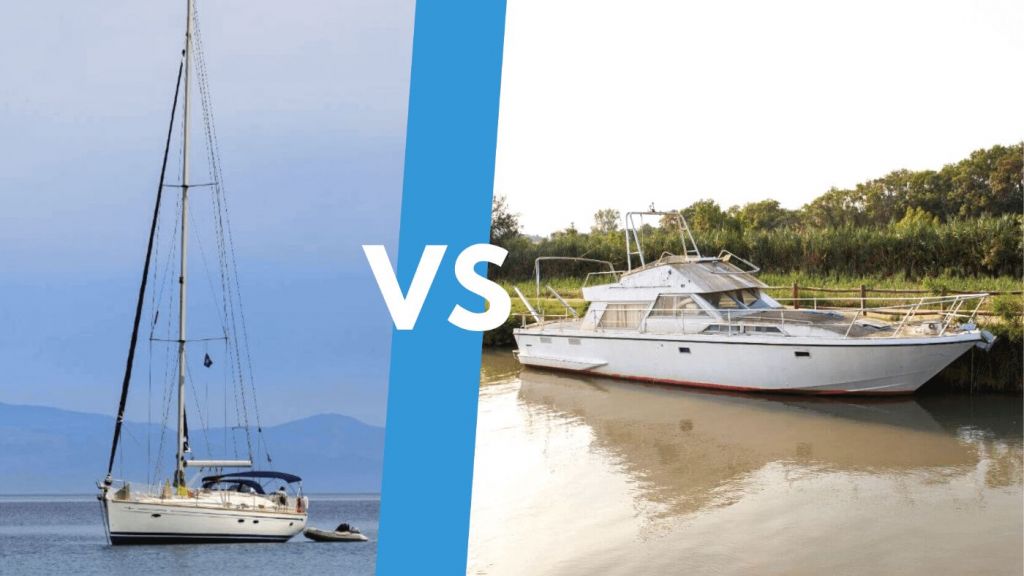
Considerations for a liveaboard boat:
What type of boat is the best liveaboard, peace of mind, ease of use, communication devices, the romance of it all.
In deciding which boat type is best to live on, you need to consider the following categories:
- Comfort - here it is a tie
- Speed - here powerboats win
- Peace of mind - sailboats are a winner
- Cost - sailboats win again
- Ease of use - powerboats take the prize
- Communication - slight win for sailboats
- Ecology - sailboats win
- Romance - subjective, but sailboats tend to win
First of all, a small word of caution - while researching the age-old 'sailboat vs powerboat' question, be careful when reading opinions - instead, look at simple facts. Unfortunately, this is a bit of a PC vs Mac kind of situation, with two zealous camps that would swear by their choice no matter what. Objectivity is tough to find.
So remember - it is all about facts and how these suit your specific needs. I myself do have a bias but will keep it to myself. I've spent a fair amount of time on both sailboats and powerboats, so I'll just be honest, and will let you choose.
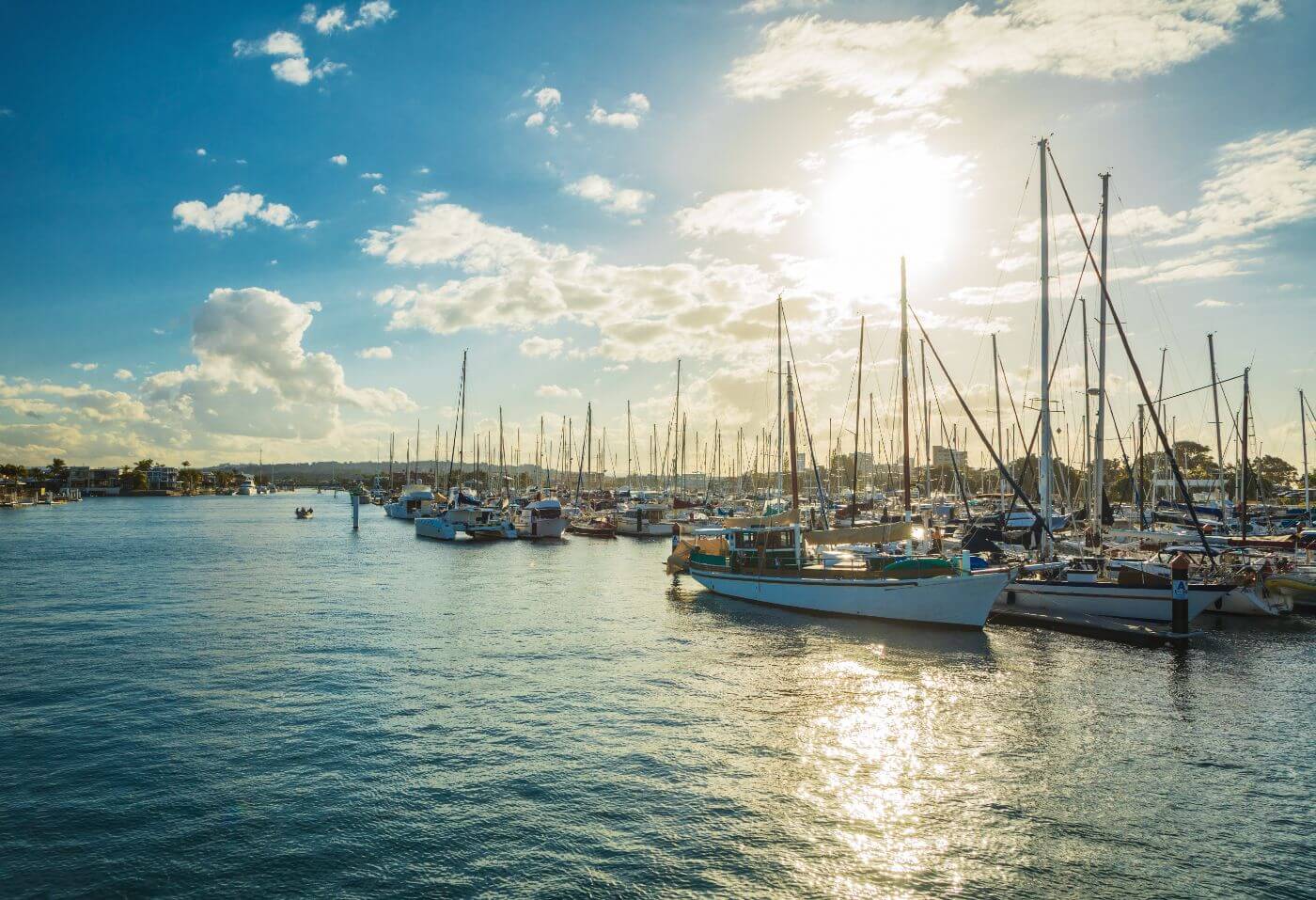
Since we are talking about liveaboards, let's start with comfort, because over time, that will become one of the most important aspects for most.
There is no clear 'winner' in this category, as there are pros and cons to both, but when we get to the subcategories, things start to be a bit more clear.
So, for instance, when it comes to space, powerboats tend to be more open. By design, they are usually boxier, which makes for a larger amount of interior space.
Sailboats, on the other hand, take hydrodynamics into account, so their hulls are narrower and sleeker, which is great for efficiency but eats away at the space.
The same goes for deck space. Since on a powerboat, there are no masts, sails, or lines to get in your way, it is more comfortable to move around. Powerboats also often have a flybridge, creating another 'floor' which adds to the overall usable space. And adds a whole lot to visibility.
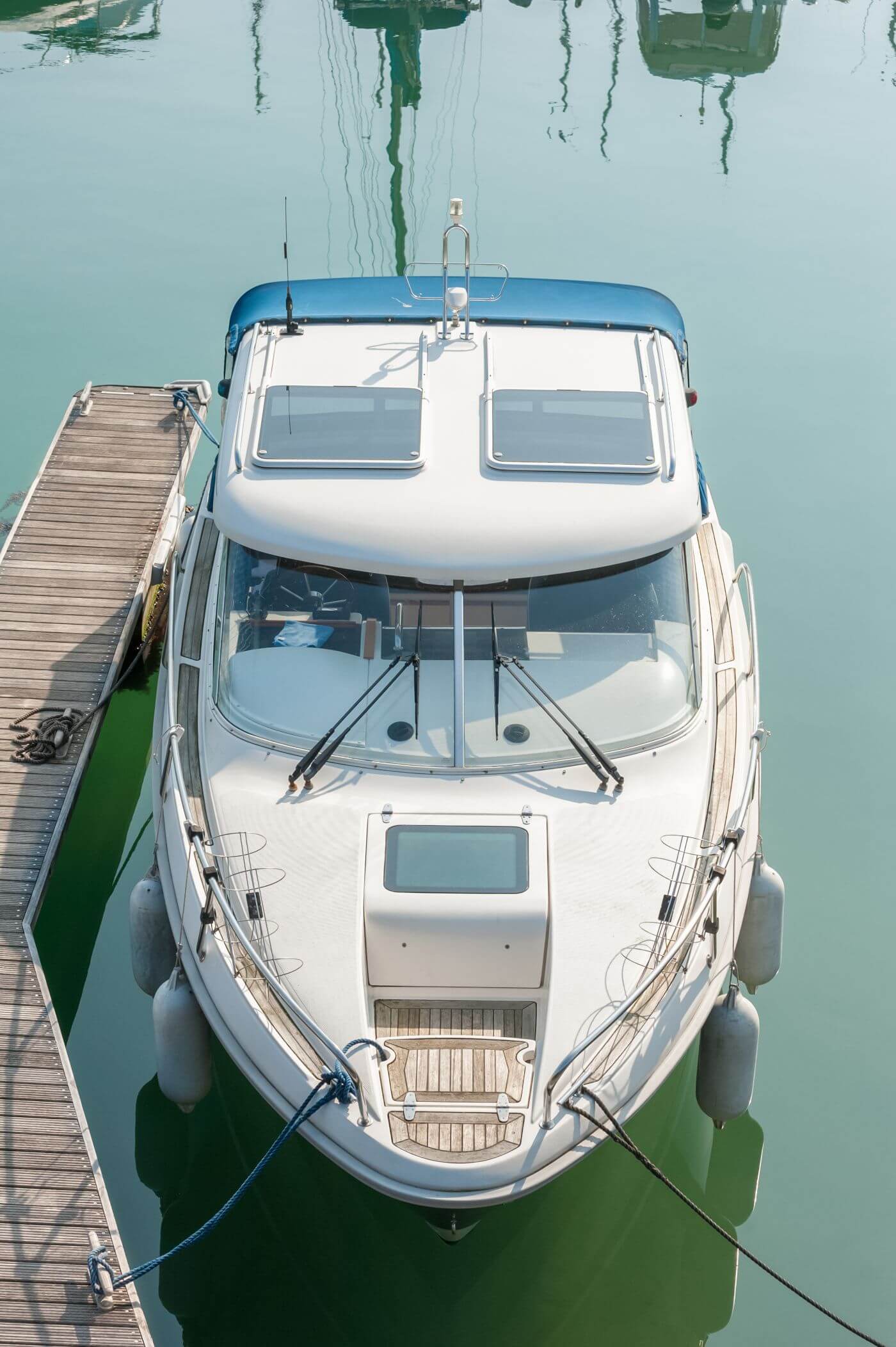
Things change quite dramatically when we get moving or into rougher seas, though. Thanks to the heavy and deep-reaching keels, sailboats are way more stable and will keep more level.
As opposed to powerboats that don't have these keels, have shallower drafts, and as a result, high center of gravity, so the movement of the waves translates to the hull a lot. They dance around on waves, so expect plenty of broken mugs and hard times when cooking.
The seasick ones will suffer, and so will comfort. This is to such an extent that smart people of the world developed gyroscopes for powerboats that keep them more level. But that is a solution for larger boats only, and it's also an expensive and power-consuming one.
Then again, when under sail, sailboats heel, especially if going 'against' the wind. Meaning your world will suddenly shift potentially tens of degrees. Those who don't like heeling, be aware.
When talking about comfort, I gotta mention the noise and vibrations. When I was speeding around the islands of Croatia on a 46 ft Jeanneau powerboat, I honestly dreaded the moments under power and couldn't wait to get to my destination so I could turn the engine off. Even if you enjoy the roar of a motor, it gets seriously annoying after a while.
For liveaboards, speed usually isn't a priority, but you should know what to expect from your purchase.
Yes, powerboats are generally faster than sailboats. The average cruising speed of a sailboat is somewhere around 6 - 8 knots, while powerboats can easily go around 20 or more if you put your foot down.
But wait, there is a twist! You see, the hull speed is the same for both sailboats and powerboats. Once you want to go over it, the power demands increase drastically, and the power to speed efficiency curve just drops to hell.
Now whether that is good or bad depends on whether you mind that or not. We will discuss cost, comfort, and other implications of high fuel consumption later. But it is safe to say that for passages where efficiency is a thing, the powerboat's power actually doesn't bring much extra speed.
But to be fair, powerboats pick a direction and go straight towards it. Wind power and direction have less influence on their speed and direction than on that of sailboats that have to tack, meaning they have to go a longer route and whose speed drops with the wind.
Very important factor. After all, it is supposed to be your home, and if your home doesn't bring you comfort but rather constant stress, it isn't much of a home, is it? So peace of mind is a big part.
Now there isn't a huge difference between the reliability of a powerboat and a sailboat. They both respond similarly to crashes and waves rolling over them, though a sailboat is harder to capsize.
What needs mentioning is the means of propulsion. Accidents happen, and if your engine breaks on a powerboat, you will either have to tow yourself with a dinghy if you have one, or pay for a tow service.
Neither is a very comfortable option if you are in the middle of a long passage, hundreds, if not thousands of miles from the coast.
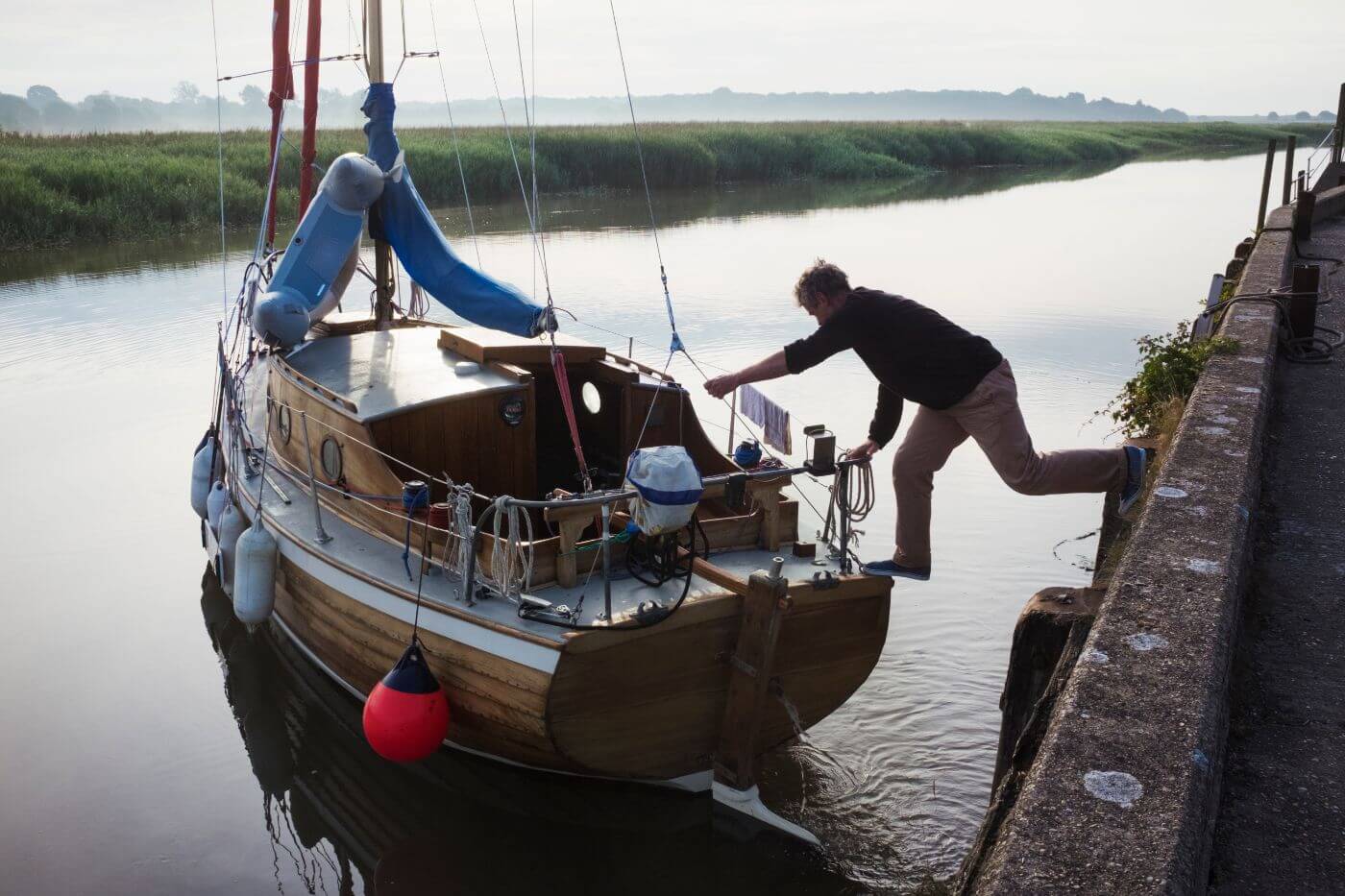
A sailboat, on the other hand, has an engine, mainsail, and the foresail, so unless all three of these break, you always have a backup. Actually, even if your sails rip and mast breaks, there is a fair chance you will be able to fashion some sort of a sail to get moving.
This ties into another topic, which is the range. A sailboat has, theoretically, an unlimited range . That gives you peace of mind when planning journeys since you won't have to calculate how much fuel to take on longer journeys and whether there are fuel stop options on the way. And if you realize your passage is too long for your diesel tank, you won't have to fill your boat with stinky fuel cans.
Unless you've got an electric engine and solar panels, that is. Which is a thing these days, one I hope to see more of.
Of course, we have to talk about the cost of it all. This will be a deciding factor for many. Let's first address what's on everybody's mind - fuel. A powerboat will consume large amounts of it, and it costs.
With a consumption of around 6 l/nm, the aforementioned Jeanneau ate up around $1,100 daily on fuel, and though we were covering quite a lot of distance that a liveaboard necessarily wouldn't, this isn't a negligible budget item for many.
Sailboats have motors too, but they don't use them that often and even if they did, all the time, because of better hydrodynamics, they need less fuel to get around.
Moving on to upkeep costs, with sailboats you'll need to pay for the maintenance of sails and rigging. Most boat owners replace sails every 5 - 10 years, and for a 30 something footer, this will cost around $4,000. Give or take a lot depending on the usage, materials, and all that jazz, but you get the point.
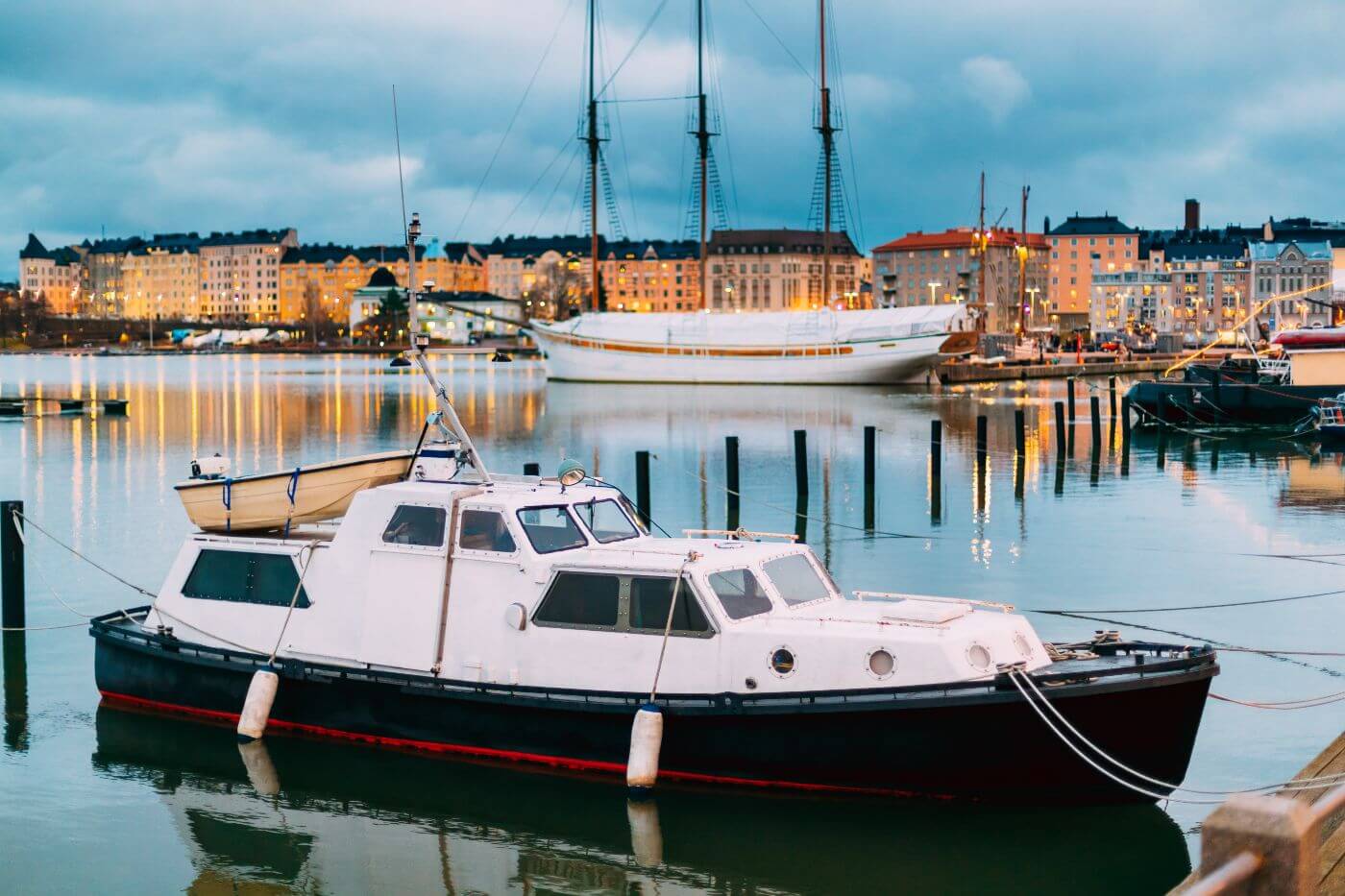
Then again, powerboat engines are significantly more expensive, and since they are used more often, they will require maintenance and replacement more often. So all in all, none is a clear winner when it comes to maintenance costs.
Last but not least, there is the purchase cost. This is a tricky one to answer - generally, powerboats are more expensive to purchase, but when buying a boat, there are so many variables to consider, like size, power, condition, equipment, that you would be better off looking at specific offers that are in your geographical and financial range than going by a rule of thumb.
Unlike the previous matter, this has a clear winner. Powerboats are way easier to use. They require less upfront knowledge to get from point A to point B.
If a person who has never been on a boat gets on a powerboat, I am confident they will be able to get to their destination without much hassle (if the seas are calm).
On the other hand, operating sails isn't intuitive. On the contrary, I mean - sailing against the wind? What the hell, right? Yet it is possible.
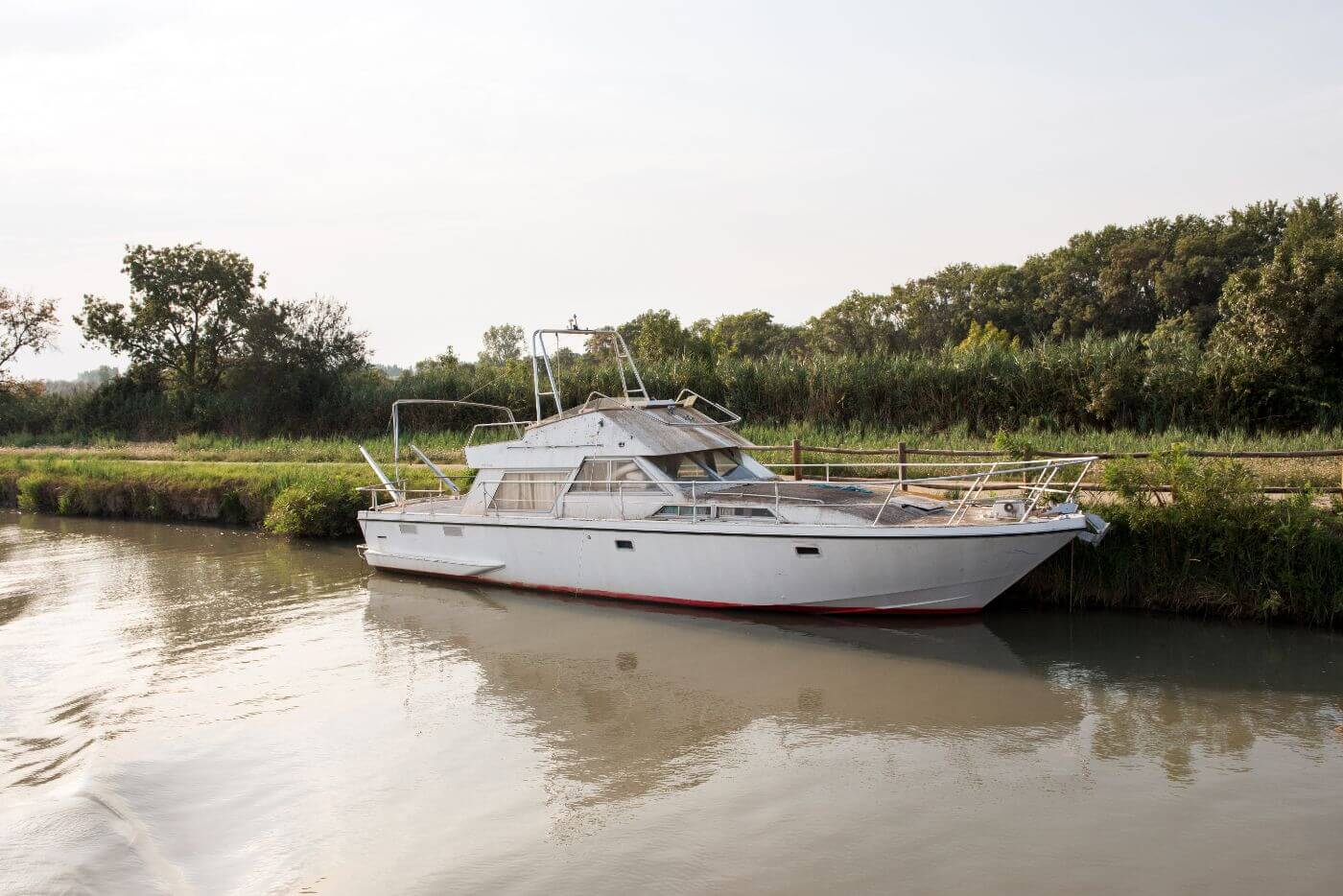
On a powerboat, you just press a lever and go; not much more effort is needed. On a sailboat, you gotta move around more and work with sails. Now whether that's a good or a bad thing I'll leave up to you.
I'm not sure if this belongs here or to the 'peace of mind' category, but powerboats have a much shallower draft.
With a sailboat, you need to be aware of your keel that goes several meters deep, and you won't be able to go to shallow places that would be reachable by powerboats.
In practice, this isn't really a thing that would make your sailing experience any different from that on a powerboat, but you gotta be mindful of it when going close to the shore.
This is something to think about, though it isn't often considered. The main communication tool of sailors is the VHF, which is a line of sight thing. So having a tall mast to put your transmitter on is a definite plus as you will gain miles and miles of additional range.
Then again, with satellite communications, you have to take into account mast shadow, which creates interference - something powerboats don't have to deal with.
I know, I know, many of you are rolling your eyes now. But the greenness of it all is a hot topic these days and is becoming hotter every year (Global warming joke, get it? Haha.). So there is a fair chance that many of the aspiring boat owners take this into account too.
And the winner here is clear - unless you've got a solar-powered boat, a sailboat is a much more eco-friendly option. And your home won't be called a 'stinky' by the fellow seamen.
This one is rather intangible, and some might say unimportant - but let's be honest, it is what we all got into sailing for, not for spacious salon layouts, good mileage, or hydrodynamic hulls, but for the romance of it. Now which side you will stand on here is a matter of opinion rather than something you can measure, so I'll give you mine, and you see what you wanna do with it.
On powerboats, you get the feeling of power and speed that an equally priced sailboat just won't provide. Which is cool, I gotta give them that.
But sailing to me seems more romantic. Not in the hearts and flowers kinda way, but in the Jack Sparrow one. You feel free, the sense of adventure is there, sailboats seem to have a soul that powerboats don't.
Powerboats are a set of parts that go, but on a sailboat, all these parts put together create freedom. And yes, I kinda stole Jack Sparrow's quote here.
I've heard somewhere that when you get on a powerboat, you do it to get somewhere. But when you get on a sailboat, you're already there.
I'm not exactly sure why, perhaps it is the unlimited range, thus the possibility to theoretically go anywhere without needing much, perhaps it is the fact that a sailboat is more in tune with the sea and weather and wind, but it just feels homier.
And finding this homey feeling on the sea is what you came here for.
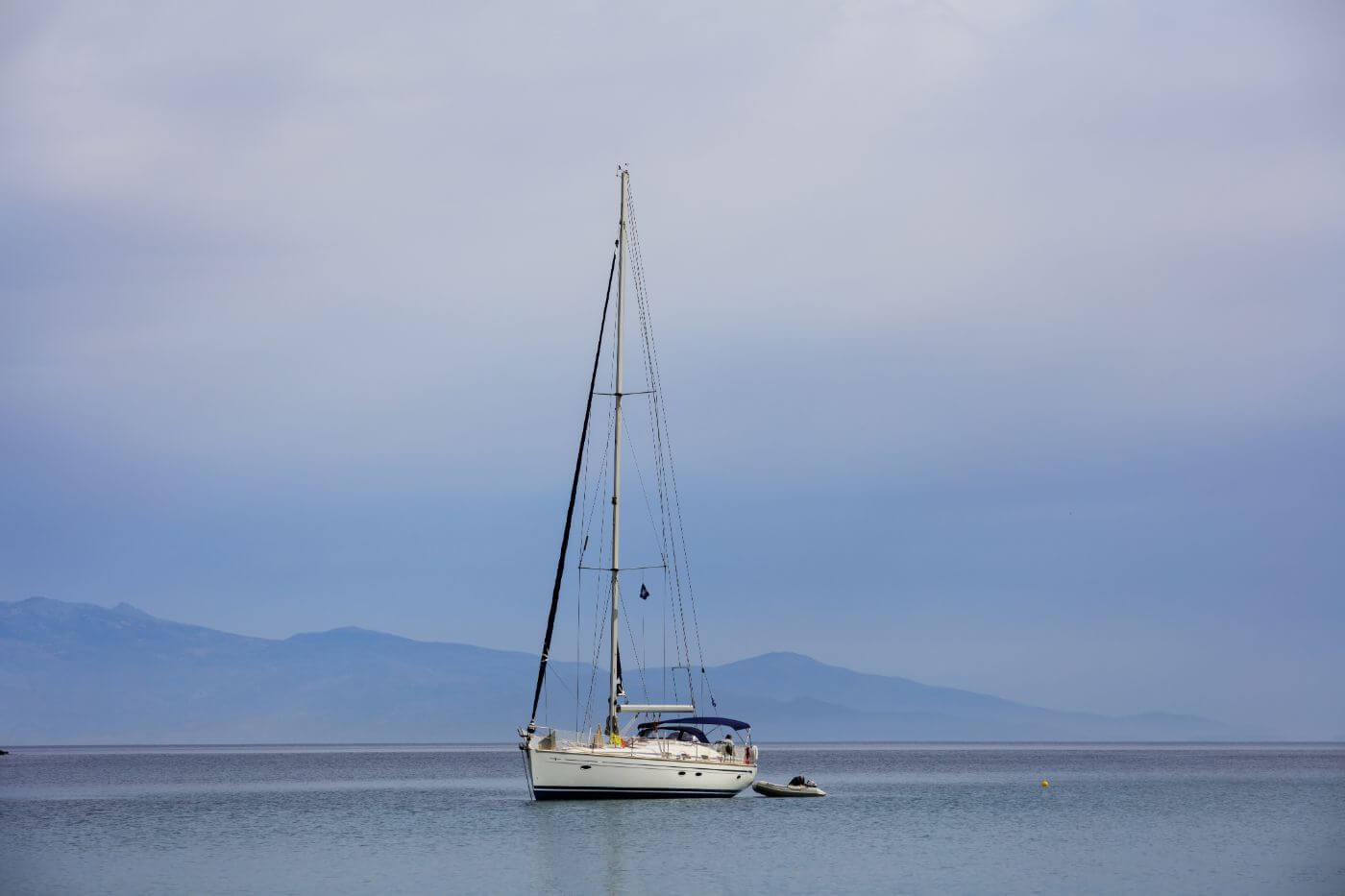
Leave a comment
Own your first boat within a year on any budget.
A sailboat doesn't have to be expensive if you know what you're doing. If you want to learn how to make your sailing dream reality within a year, leave your email and I'll send you free updates . I don't like spam - I will only send helpful content.
Ready to Own Your First Boat?
Just tell us the best email address to send your tips to:
- Ferretti Yachts
- Pershing Yachts
- Custom Line
- Leopard Catamarans
- Pre-owned & Brokerage Yachts
- News & Events
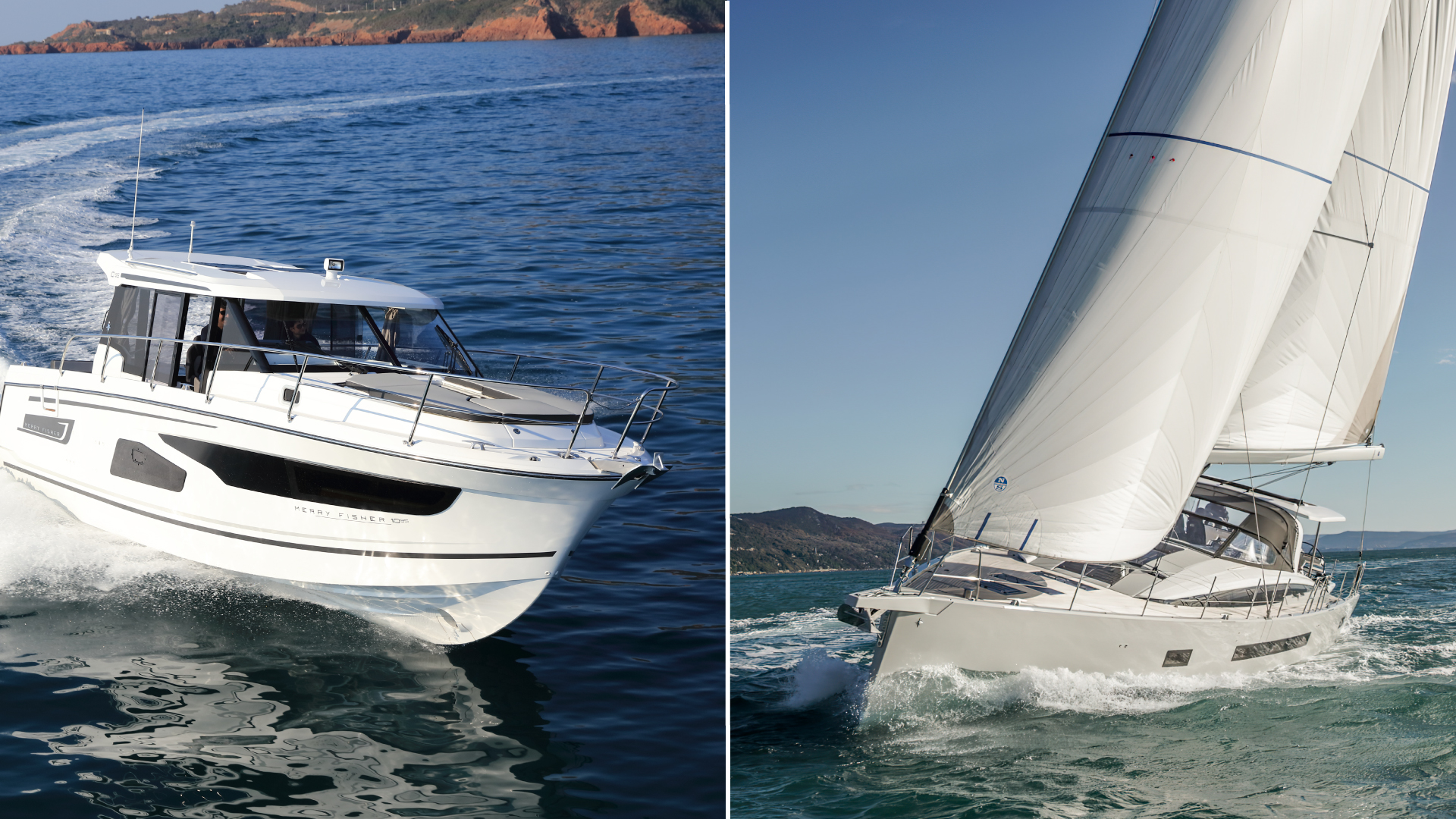
Sailboat vs motorboat : which one should you choose?
Understanding the advantages and disadvantages will help you choose the right vessel for yourself.
We often write about the many different factors involved in choosing a boat – which size is right for you, what are the budgetary expectations, what yachts are particularly suited for certain activities, and more. However, the starting line of a boat purchase is choosing between a sailboat and a motorboat. Both have their distinct advantages and disadvantages. Let’s break it down here.
Sailboat vs motorboat
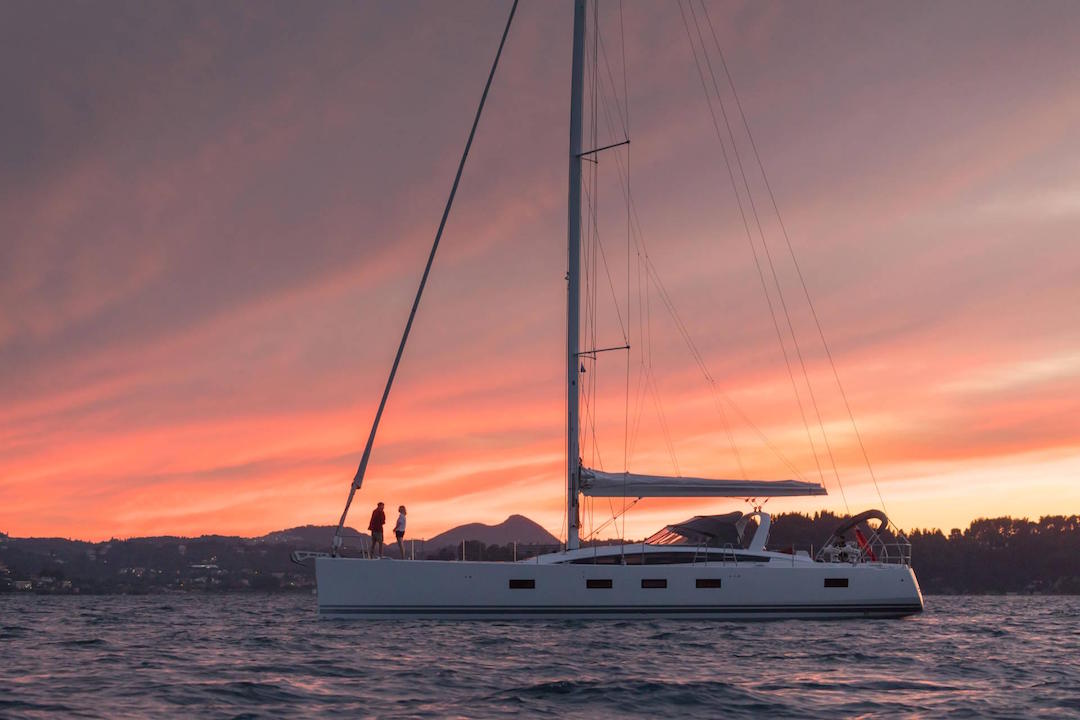
Sailboat advantages
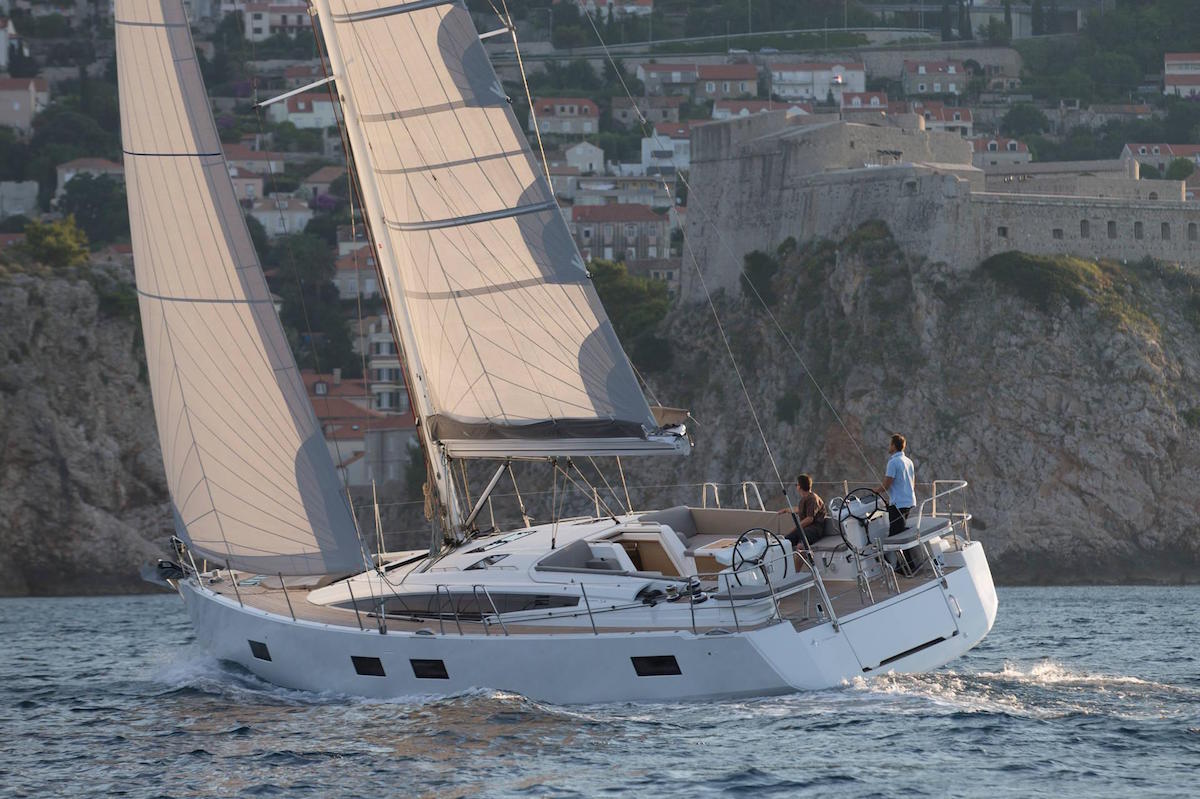
Go further . A sailboat will never run out of fuel, so boaters can travel further and longer before needing to call at a port for supplies.
Cheaper engines . As a sailboat uses a significantly smaller engine so the unit will cost less to buy, use less fuel to run, and is cheaper to maintain and repair.
Better for socialising . Without a noisy engine running, communicating becomes easier. What’s more, captains get to socialise as well, as they helm the vessel from the stern and can be included in the conversation easily.
Accomplishment . A sailboat requires the captain to dot every i and cross every t. The boater bends the elements to their will, using their resolve, knowledge and skill to bring the boat where they want to go. The limit of the adventure is simply their imagination. And once they return to land, they return tired, yes, but they return accomplished.
Serenity . If one does not wish to socialise, they can always just enjoy the feeling of the wind and the sound of the waves. There is no drone of an internal combustion motor to break the serenity of the journey.
Sailboat disadvantages
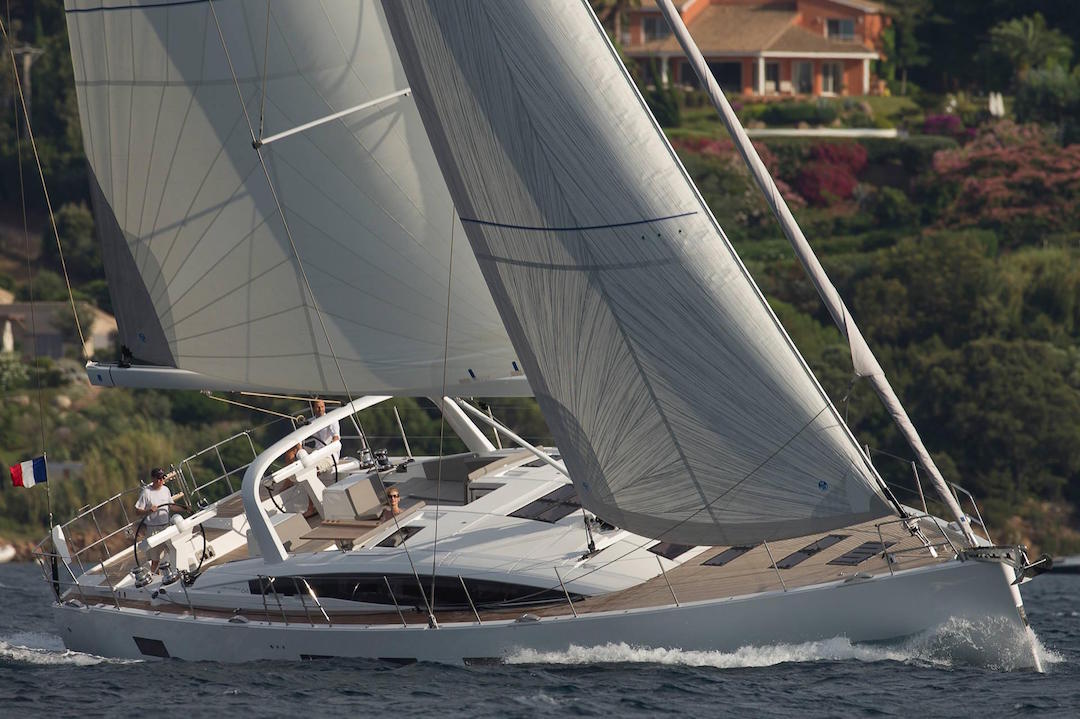
Wind . The best part of a sailboat is also its weakness. Both too much and too little wind means you may have to cancel your plans for the weekend. Perhaps the best way to deal with this is to embrace the unpredictability.
Less shelter . Loving the elements is a part of sailing, but sometimes there is too much of it, as there is little to no shade on the deck of a sailboat. This is because any shelter must be designed around the masts and sails, and that is often impossible.
Costly gear . Even though there are significant savings in the engine department, money will still be spent to maintain or replace sails and rigging. However, they do have long lives. Sails typically need replacing around 3500 hours, and rigging around ten years.
Expensive in time and energy . Time is used to build up the skills and knowledge, to familiarize the sailor with character of their vessel, and to get to know the seas around them. Additionally, sailing is a hands-on hobby. The sails and steering require constant adjustment, and the sailor must concentrate on the seas and weather around them. However, there are autopilot systems today that can really help the captain in this department.
Motorboat advantages
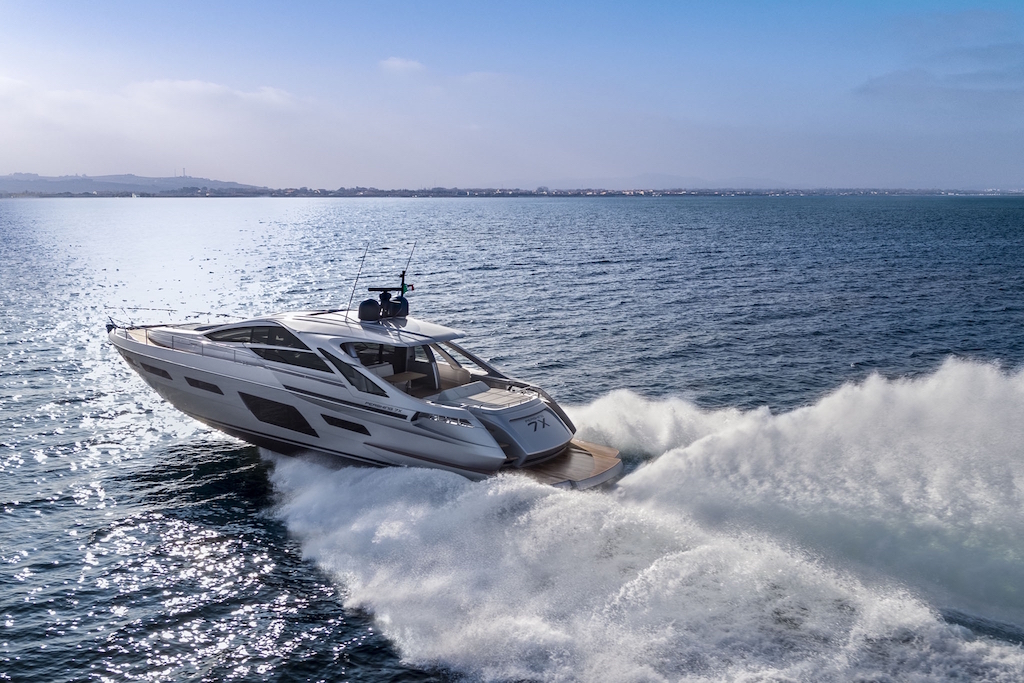
Spaciousness . Motorboats have less tools and parts on the main deck, and thus have larger and more comfortable living spaces up here. They also have more features below, like extra cabins and heads, as a motorboat can carry more weight and still move effectively.
Less planning . As long as the engine has fuel and the boat is in good condition, you can head out to see. Wind is capricious, and sailors need to know the weather as well as the direction and speed of the wind, heading out only if conditions are favourable.
Simplicity . Motorboats require less training and experience to pilot as compared to sailboats. The majority of the knowledge needed is to understand the rules of the water.
Smaller package . Seems counterintuitive, but a motorboat is almost always shorter and shallower than a similarly-sized sailboat. The main mast of a sailboat must be taken into account when going under bridges, and they also sit deeper in the water due to the design of their hulls.
Motorboat disadvantages
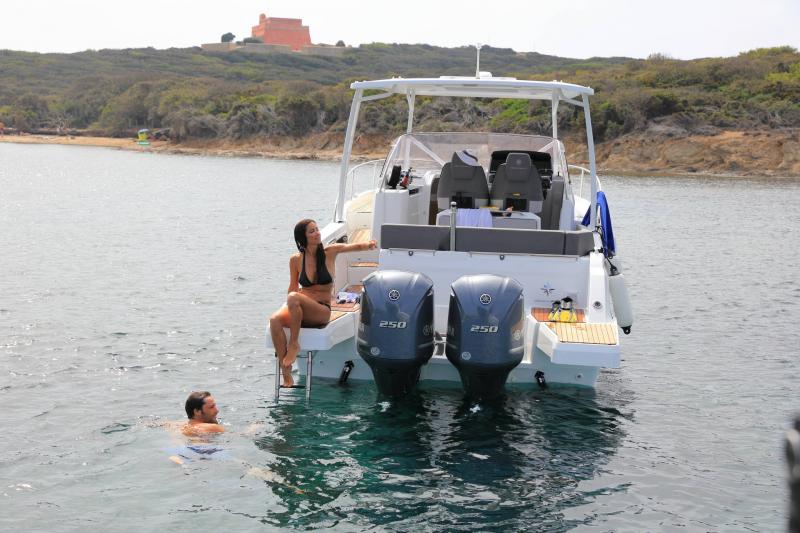
Engines . Engines are expensive, so take care of them well! Regular maintenance is needed, and the cost of the upkeep and repair should also factored in when purchasing a boat.
Noise . Larger yachts have the extra room on board to isolate boaters from the sound of a powerful engine, but on smaller boats the noise can be pretty loud. When undergoing sea trials, run the engine across the rev range and check the noise levels.
Sailboat vs motorboat – let’s conclude
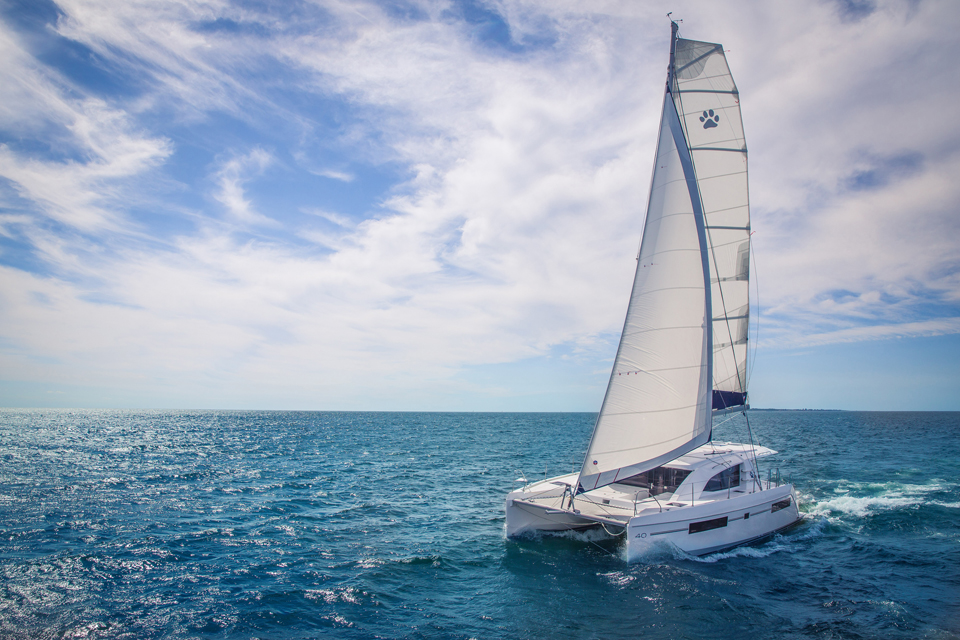
Click one of our contacts below to chat on WhatsApp

Social Chat is free, download and try it now here!
Request car price
Better Sailing

Sailboats Vs Powerboats: Why Sailboats are Better
Are you thinking of which boat to purchase and which will cover your needs? Then, continue reading this article so as to find out the pros and cons of sailboats and powerboats as well as why are sailboats better than powerboats. Sometimes, it can be difficult to choose between having a sailboat or a powerboat. Both will have the same marina costs (depending on their size), and they will both have maintenance fees connected to their motors and other gear. The key distinctions are in how you want to use it and the type of water experience you plan to have. If you want to go fishing and relax on the water, a powerboat is the way to go. A sailboat will be more your style if you take satisfaction in navigating the water and weather with your own hands. So, let’s dive deeper into the subject, follow me!
Sailboat Pros
A sailboat is ideal for people who wish to connect with the ocean and weather on a primitive level, as well as learn to navigate the world on their own. A sailboat is a boat to choose if you want to have the ultimate boating adventure and see the world by boat. Also, sailboats are literally powered by the wind. Although most sailboats have modest motors for docking, some owners take pride in their abilities to sail and dock while relying solely on the tide and wind. In other words, a great plus of sailboats is that they’re more environmentally friendly than powerboats. Let’s see other key advantages of sailboats:
- There are small boats that have trolling motors onboard. However, many sailors use the motor as little as possible and prefer to rely on the wind and tides. As a result of not having a large engine, you save money on both fuel and maintenance costs. And, as you minimize motor usage you subsequently minimize your impact on fuel consumption.
- A sailboat is the only boat that can cross large distances , even internationally. Meaning that you don’t have to wait for the proper weather conditions, as your sails can take you anywhere on the globe. But, of course, you would need a seaworthy vessel capable of crossing oceans. And, you should always check the weather forecast beforehand, even if you have a sturdy sailboat.
- Because a sailboat’s engine is much smaller than a powerboat’s and isn’t utilized nearly as often, fuel and maintenance costs are far lower. Also, their engines are cheaper to operate as they use less fuel.
- On a sailboat, it’s easier to socialize because it’s quieter, and the captain controls the boat from the stern, allowing them to easily communicate with everyone.
- Under calm conditions, sailboats don’t create much noise, just the noise of the wind and waves. Meaning that most of the time your voyage is silent since sailboats rely on the wind rather than the force of an engine.
- Though it may appear that the powerboat is geared for the adventurous, the sailboat is the one offering the greatest adventure. You can plan the perfect experience that is only limited by your imagination and stamina by mapping your voyage according to the weather and tides. There is no need for fuel; all that is required is labor.
- Sailing provides an active way of life. People who own powerboats are said to live for the destination, whereas those who own sailboats live for the voyage. A sailboat journey necessitates continual sail adjustment, steering, and, on occasion, changing your plans if the weather changes. Meaning that you have to pay attention to detail as well as be vigilant during the whole voyage. And, that’s why single-handed sailing is considered to be a challenging way of sailing.
- A good day on the water on a sailboat provides a sense of fulfillment that a powerboat cannot provide . It comes from using the power of nature and your own body to move to and from your desired location.
Sailboat Cons
- Small to medium sailboats have less room on and below deck due to the shape of the hull and the requirements of the masts and sails. So, you’ll need to purchase a larger sailboat to get a comparable amount of space and additional amenities.
- You can’t sail if the wind isn’t on your side , so your voyages may not go as planned. When you live and travel by boat, you have to organize your travels according to the elements and weather patterns.
- While powerboats can have multiple levels and provide sun protection, a sailboat’s masts, sails, and rigging provide less sun protection when you’re on the deck.
- When it comes to the expense of maintaining different boats, it’s often six of one, meaning half a dozen of the other. Bear in mind that the most significant expense for sailboats is the sails and rigging . As with everything, the wear on sails depends on how much use they get, but sails should typically be replaced after about 3,500-4,000 hours of use, and the rigging should be replaced every ten years or so.
- The shape of a sailboat’s hull means that it can sit on a lower level in the water . So, you can’t sail in shallow waters easily or get too close to beaches and tight coves when anchoring.
- You will probably need more time to understand how to sail a boat because it isn’t that simple as turning on the engine and sail the seas. Meaning that you have to understand how to work the equipment onboard, and how wind direction, speed, tides, and other factors will affect your journey. Apart from that, if you’re a beginner at sailing, you would need to take some sailing courses as well. This can add to the cost of the overall sailing preparation.
- As a matter of fact, sailing is an activity that takes a lot of time . It necessitates extensive training, meticulous preparation based on tides, winds, obstacles, and destinations, and attention to detail for the duration of the voyage. Of course, this is not always a disadvantage. Instead, for some people, this is a big plus.
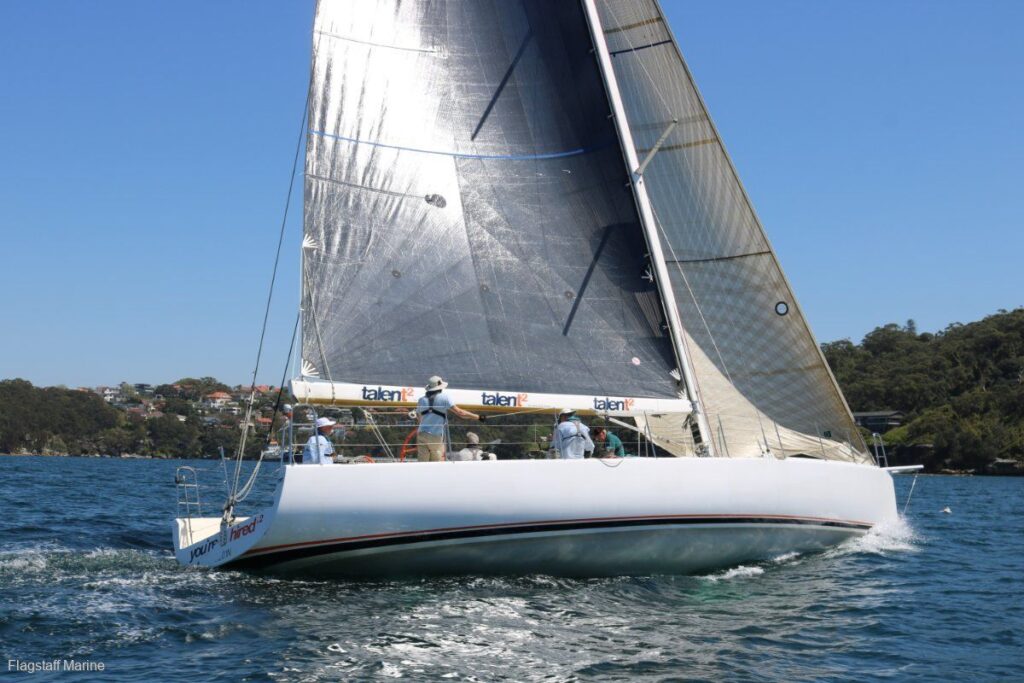
Powerboats Pros
A powerboat, often known as a motorboat or speedboat, is a boat with an engine that propels it forward. Some motorboats have inboard engines, while others have an outboard motor on the back, which combines the internal combustion engine, transmission, and propeller into a single portable unit. Some powerboats even have a hybrid inboard-outboard engine, with the internal combustion engine on the inside and the transmission and propeller on the outside. Powerboats come in a wide range of sizes. Many say that a powerboat is the ultimate bay and ocean boat, and it’s ideal for short fishing trips out into the open water. You can get in, turn the key, and go wherever your heart desires whenever you want. So, let’s now see the pros of having a powerboat:
- A powerboat is an appropriate choice for you if you have a need for speed . It is true that only fast sailboats will be able to match the speed of a powerboat’s two engines. And, even like this, there’s no comparison in terms of experiencing speed. On a quiet day, most sailboats can reach speeds of 7 knots, whereas powerboats may reach speeds of 15 to 20 knots.
- Powerboats have more interior and deck space than sailboats. A powerboat also has more facilities, such as larger cabins and stand-up galleys. This, of course, depends on the kind of powerboat you will purchase. Not all powerboats have bigger interior space.
- Powerboats aren’t as reliant on the wind as sailboats are. You simply jump in and go when you want to travel somewhere. On the other hand, this means more pollution as you will be using the engine at all times…
- It is a fact that sailboats necessitate extensive training. Powerboats rely on their engines to overcome nearly all environmental constraints that could cause the trip to be delayed or altered. The rest is quite straightforward after you’ve grasped the water’s principles. So, if you’re a beginner, you will need less training if you aim to purchase a powerboat.
- Because powerboats sit relatively low in the water, they can readily dock in shallow areas, allowing you to get closer to beaches and other shallow waterways.
- Powerboats have lower clearance than sailboats. So, you’ll want to get a powerboat if you have bridges between you and many of your intended destinations. You don’t have to be concerned about mast height prohibiting you from going on a voyage.
Powerboats Cons
- Powerboats are more expensive to operate, despite the fact that they are easier to handle and provide greater space. You have to rely on the engine to go around, and you’re going to use a lot of fuel each time you go out, which can rapidly add up. So, it’s also less environmentally friendly than sailing, which consumes very little fuel.
- Your powerboat’s range is limited by the capacity of its fuel tank. Unfortunately, maintaining the fuel tank will be costly. Furthermore, the price of gasoline is typically volatile and unpredictable.
- Repairing a boat engine, whether you have one or two, is also going to be expensive. So, what you have to do in this case is to frequently maintain your engine, just like you would for your car. Like this, you will keep it operating smoothly for as long as possible.
- Because powerboats have shallower drafts and a higher center of gravity than sailboats, they don’t manage wind as well as sailboats . This can make a journey in windy weather less pleasant and uncomfortable.
- The noisy motor on the powerboat will be a con for you as well as the persistent noise of a powerful engine. The motor is also loud and stinky, which is an important con as it minimizes the pleasure of being out on the water. That scent is especially unpleasant for persons who feel seasick.
- Powerboat engines are also more pricey. If you need to replace or repair the engine on your boat for whatever reason, you should expect to pay a lot of money. As a result, it’s critical to get your engine checked and maintained on a regular basis to keep it working properly.
- Basically, expect to spend more on a powerboat and have an experience that is more focused on the water activities than on the pleasure of being on the water.
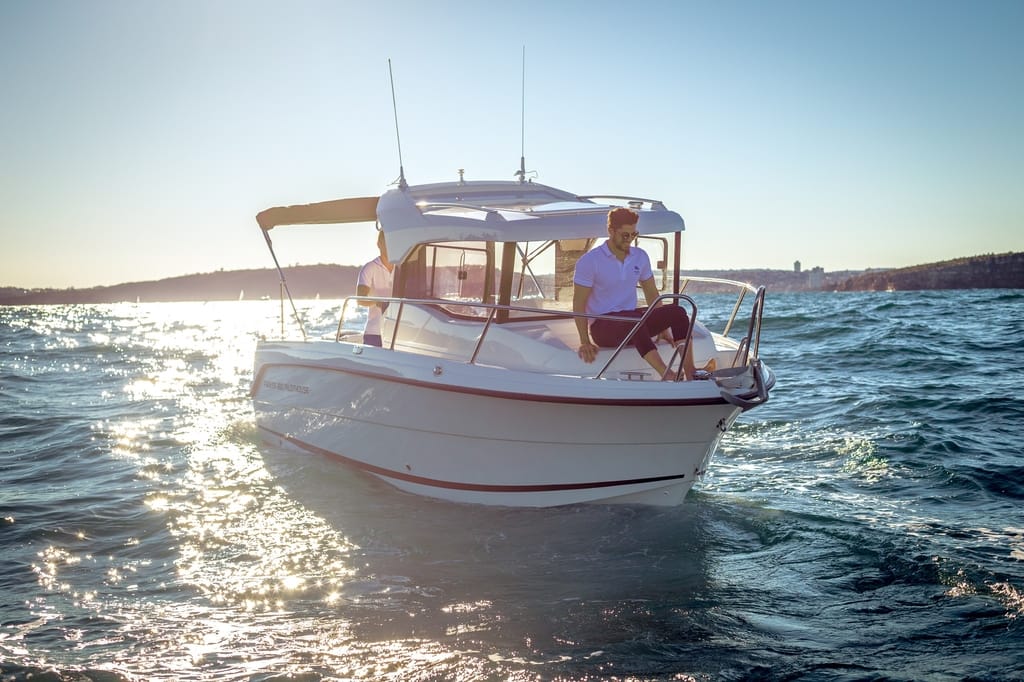
Reasons Why Sailboats are Better than Powerboats
- Sailing is not only wonderfully peaceful, but it is also incredibly environmentally friendly. I’m not totally against fuel, but we have to accept that using wind power instead of gas is a fantastic approach to protect the earth. And if that isn’t enough to persuade you, consider the smell. Wind energy is environmentally friendly. It doesn’t have any scent to it. There are people who enjoy the odor of gasoline. However, I prefer the smell of the salty sea or the blossoming woodland that surrounds the lake. Of course, you’ll utilize your engine from time to time, which is good. It’s fantastic, though, to be able to go without the scent and noise.
- Sailboats are the first to arrive. Meaning that you have right of way over motorboats if you’re sailing rather than motoring. If a motor vessel is huge and difficult to maneuver, it may take precedence over the sailboat. Very big motor vessels in wide channels, huge motor vessels (over 65 feet) in small channels, and motor vessels in distress are the only exceptions. When a sailboat passes a motor vessel, the latter has the right of way. However, note that if you utilize the engine on a sailboat, you are deemed as a motorboat.
- Although it may appear to be a bold statement, sailboats are far safer than powerboats . Because of the properties that sailing requires, sailboats are more stable than powerboats. Meaning that they tend to be heavier and have a deeper draft. Most sailboats also feature a centerboard or keel, which makes capsizing practically difficult. Moreover, sailboat hulls are made of heavier materials. All of these characteristics contribute to the sailboat’s increased stability on the water.
- The Achilles heel of the powerboat is its speed. Because it is so quick, it is also less safe. For starters, a powerboat can travel far quicker, which makes it more dangerous in general. The hull of a powerboat has a much smaller draft than that of a sailboat, allowing it to travel quicker. It’s also light, a feature that allows it to fly. When planing a boat, the bow comes out of the water, thus reducing water resistance . This is fantastic in calm conditions, but it can be dangerous in strong gusts. But, the powerboat may tip over if the wind catches the hull.
- Sailboats are not only safer, but they are also more dependable. In other words, when a powerboat runs out of fuel, it’s game over. To save yourself and your boat, you’ll have to wait. A sailboat usually just has enough fuel to use when you don’t want to operate the sails. It also makes light-air sailing more efficient, as sailing in light winds may be exhausting and slow. If you run out of gas, though, nothing happens. And, even if the wind fully vanishes at the same time, it’ll only be a matter of time until you can get back at it and save yourself. However, on a sailboat, it is possible to become dismasted. But that is a one-time occurrence. Running out of fuel on a powerboat is a foregone conclusion because that’s what they’re built for: burning a lot of fuel.
- So, in addition to being less noisy and stinky, a sailboat is also far less expensive than a powerboat. A powerboat is famously expensive to operate, and with good cause. It consumes a lot of fuel. Actually, it’s roughly 25 gallons of fuel per hour if you have a really fast powerboat. That works up to about $300 per hour! Smaller powerboats, on the other hand, require a lot less. Inland water cruising at slower speeds minimizes fuel usage. Most powerboats, on average, utilize 1 gallon per hour. So an inland weekend trip will set you back anything from $30 to $80, which isn’t awful – but that’s only for the gas…
- You could end up tacking upwind for the remainder of the afternoon if you make a mistake when navigating the sea. Meaning that sailing works with nature. Instead, a powerboater would spin the wheel and head in that direction. True, the engine is probably the most advanced technology here. Have you ever thought about why a powerboat consumes so much fuel? After all, it’s on the water. This is because powerboats act against nature. Each wave must be plowed through and pushed ahead. As a result, you must first fill it with plenty of liquids. A sailboat propels itself ahead using drag and lift . It almost appears to be symbolic, as though it wishes to move on. All you have to do is pick the right sail point and let it go.
What to Consider Before Buying
If you still don’t know which one is right for you then you have to determine what matters the most to you. For example, speed or safety? Cruising around the world, or regular sailing? Big interior space or it doesn’t matter? When picking between a sailboat and a powerboat, there are numerous factors to consider. In the end, it comes down to what type of boating experience you want and how much time you will dedicate to sailing. Motorboats are generally more of a pastime, whereas sailboats are more of a way of life. With a powerboat, you can quickly enjoy a weekend cruise with your family without worrying about preparation before and during the voyage. However, be prepared to pay high fuel expenses and forego some of the benefits of being on the water.
A sailboat, on the other hand, is the vessel for you if you want to get closer to nature, yourself, and possibly sail around the world. Let’s not forget that a sailboat is more environmentally friendly than a powerboat. But, keep in mind that operating a sailboat necessitates more training, more time spent planning voyages as well as extra maintenance costs. Sailing with a sailboat, on the other hand, is a more pure boating experience that encourages you to concentrate on the task at hand and the environment around you.
Sailboats Vs Powerboats – Bottom Line
So, these are the pros and cons of a sailboat and a powerboat as well as the reasons why sailboats are generally better. However, let’s not underestimate powerboats; as you’ve seen they also come with many advantages. Generally, the difference between a sailboat and a powerboat is that a sailboat is quiet and consumes less fuel. Sailboats are also substantially less expensive to buy and maintain. They’re also more dependable and safer. Powerboats, on the other hand, are less demanding and go faster than sailboats. But, keep in mind that what matters most in sailing is the voyage and the overall sailing experience. And, as powerboats go faster, you will quickly reach your destination but they’re not able to circumnavigate the globe.
So, it’s all about your needs and preferences! I hope that this article will help you determine what you need from a boat and that you will eventually make the right choice. Wish you all safe & happy voyages!
Peter is the editor of Better Sailing. He has sailed for countless hours and has maintained his own boats and sailboats for years. After years of trial and error, he decided to start this website to share the knowledge.
Related Posts

The Ultimate Guide to Choosing the Best Fishing Line for Trolling

Lagoon Catamaran Review: Are Lagoon Catamarans Good?

Best Inboard Boat Engine Brands

Are O’Day Sailboats Good? A Closer Look at a Classic Brand
- Buyer's Guide
- Destinations
- Maintenance
- Sailing Info
Hit enter to search or ESC to close.
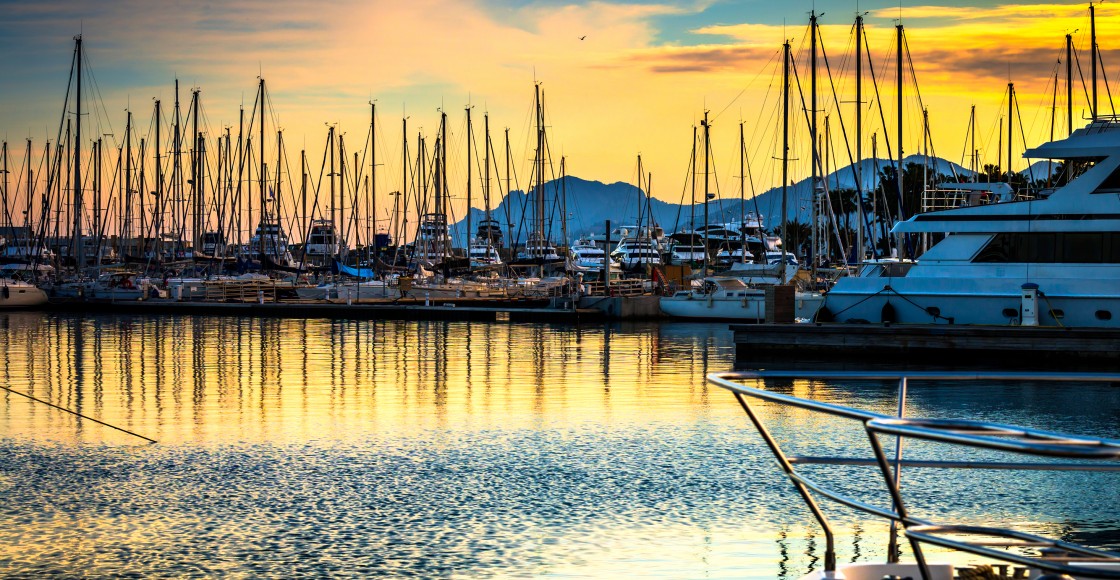
Here’s the Difference Between a Motorboat and Sailboat Rental

Table of Contents
Some Good Motorboat Rental and Sailboat Rental Options
Have you ever wondered what the difference is when boaters and fishermen talk about when to rent a motorboat and when to rent a sailboat? What are some of the differences you might expect when it comes to deciding whether to rent a motorboat or rent a sailboat? By reading all of the details below, you should soon be able to clearly explain some of the biggest differences between a motorboat rental and a sailboat rental, and also know when to choose each particular type of rental. Boatsetter offers many types of boat for rent , and a lot of these boats are either motorboats or sailboats. Read along below to learn more about each type of boat rental.
Motorboat Rental or Sailboat Rental?
As the name of each type of boat implies, the biggest difference between a motorboat rental and a sailboat rental is the source of power. Sailboat rentals are generally powered by a system of sails, which can come in various shapes and sizes. Motorboat rentals come equipped with a wide range of different inboard and outboard motors . There are quite a lot of technical specifications involved with both kinds of vessels, but sailboats are mostly for people who want to navigate waters by using their own skill and effort. People who mostly plan to fish and relax while on the water might prefer the mechanical aspects of having a motorboat rental. Some boats have sails and motors, like the ones in the Rolex 52 Super Series Championship , held recently in Cascais, Portugal, in extremely challenging and variable windy conditions!
Did you know that it takes one of these sailors just 2-3 seconds to hoist a TP52 spinnaker to the top of the 22-meter mast, at which time the boat is already at a speed of well over 20 knots? So, unless you are an aspiring TP52 world sailor, it is best to start with boats that let you navigate either by sail or motor—in much calmer, gentler waters! Here is a list of advantages and disadvantages to help you choose which type of boat you’d like to try first.
Some Advantages of a Motorboat Rental
It is a good idea to rent a motorboat if you are in a bay or other open ocean area. These boats are ideal for short fishing trips. They are shallow in the water, so you can easily dock them, which is important to gain closer access to beaches and other waterways. Also, when you tow a motorboat, you don’t need to worry about the mast height as much as you would with a sailboat. Much like a car, you can simply get in, turn the key, and go wherever you like. Motorboats are generally much faster than sailboats, even in extremely windy conditions. Motorboats also have more deck space and more interior space. They often feature more amenities like cabins, restrooms, and other larger rooms. Because they are similar to cars, motorboats use their engines to conquer environmental factors so weather conditions are not often a problem. As long as you follow some of the basic boating rules for your chosen location, making the most of a motorboat rental should be quite simple.
Some Disadvantages of a Motorboat Rental
Motorboats rely on fuel so you can easily get stuck far from the shore if you run out. In certain boating locations, it can be expensive to keep the fuel tank filled. Likewise, when you have an engine or two, repairs and maintenance can get expensive. Next, since motorboats have shallower drafts and a higher center of gravity, they can’t deal with windy conditions as well as sailboats, so it can get quite scary out on the water at times. Finally, the loud engine noise on most motorboats can be distracting and annoying if you are out on the water trying to enjoy nature.
Some Advantages of a Sailboat Rental
Sailboats are perfect if you want to connect to the water and weather on a deeper level and enjoy nature to its fullest. It is much easier to relax and hold social events on sailboats because they are much quieter. Sailboats are extremely environmentally friendly because they simply use the wind for power. If you want to travel long distances across open waters, sailboats offer a far better and more economical option. While sailboats do often have small engines to navigate tight conditions and narrow waterways, they are not used very often, so fuel and upkeep costs are much lower than on a motorboat rental.
Some Disadvantages of a Sailboat Rental
Sailing can be very time-consuming because it requires a lot more training and planning. If you are new to the sport, it will take you longer to understand how to sail because you can’t just turn the key and go like when you have a motorboat rental. You have to understand how all of the sailing equipment works, and how wind direction, speed, and ocean tides might affect your trip on the water.
Also, sailboats usually have quite a lot less space on and below deck than most motorboats, which can often feature several levels that can provide shelter when the weather conditions turn bad. The shape of a sailboat’s hull makes it sit lower in the water, so it is hard to sail in shallow waters or get too close to beaches when anchoring. The biggest problem is if the wind is too light or variable, you can’t go where you want to, so you often have to adjust your plans according to the weather conditions .
When to Rent Each Type of Boat
Luckily, with Boatsetter, you don’t necessarily have to choose which type of boat to buy. You can learn how to rent one that meets your specific needs . If you don’t have much time available, it might be best to rent a motorboat for a quick jaunt on a local lake. When you have more time and especially when weather conditions are perfect, you may choose to rent a sailboat instead and follow some of your more exotic boating dreams.
Have you ever marveled at the spectacular motorboats and sailboats in marinas around the world? It is always a good idea to meet some of your fellow boaters and find out what they enjoy doing out on the water. Always remember that you don’t actually have to own one of these boats to live like a millionaire and enjoy the boating lifestyle. It is easy to arrange a motorboat rental or a sailboat rental for whatever length of time you choose.
On certain occasions, you may even want to hire a captain and a full crew for the boat, especially if you are an inexperienced sailor or if you are planning a day of drinking out on the water! We have so many good options available for you, so visit Boatsetter today to see how easy it is to rent a motorboat or to rent a sailboat.

Boatsetter empowers people to explore with confidence by showing them a world of possibility on the water. Rent a boat, list your boat, or become a Boatsetter captain today.
Browse by experience

Explore articles
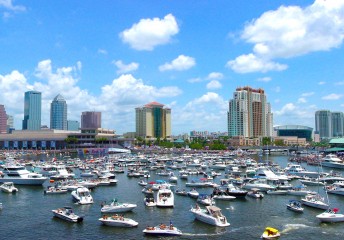
The Best Tampa Hot Spots to Discover by Boat
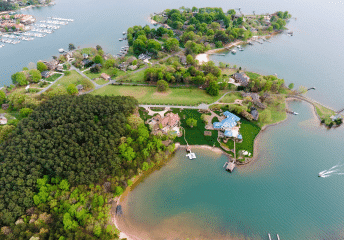
Things to Do at Lake Norman

7 Best Sailboat Accessories
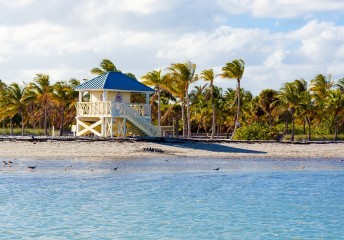

The Key—Biscayne—Times to Hit the Waters

Choosing the right liveaboard boat
We’ve received many inquiries from our blog about choosing the right liveaboard boat. Folks have many questions ranging from style of boat, length of boat and horsepower to interior layout and aesthetics. I decided to post our experience with choosing Blue Turtle and what we initially looked for versus what we might have done differently today. First though, I want to point out that we are liveaboard cruisers, which mean we liveaboard our boat in a marina, but we also cruise places rather frequently (at least once a month). This post is about liveaboard boats that are fit for cruising. If you want to liveaboard but never plan to leave the dock, you can really choose any type of boat that suits your space and aesthetic needs. Houseboats would be the way to go as they offer the most space, but they are more fit for lake cruising than coastal cruising.

25 thoughts on “Choosing the right liveaboard boat”
i wont to thank you for all that info it helps to find a right boat for people that do not know boats just starting out ….
Thanks Royal. We didn’t know much starting out even though we had the advantage of our parents living aboard. We hope this write up is useful to those starting out.
especially when the boat mentioned starts out at 500K!
Many thanks for taking the time to write this! Very helpful. My wife and I might be looking for a liveaboard in FL in a few years.
Hope this post helps a little bit. Please let us know if you have any questions. We’ll be glad to answer them 🙂
Thanks so much for sharing your knowledge and experiences. You answered all my questions and have probably saved me a lot of time and headaches. Truly appreciated!
So glad this helps! Let us know if you have any more questions.
recently found your blog and FB. thank You for the information you are supplying us newbee’s A little more detail would be very helpful when you post, as we are making the leap into a trawler/cruiser. this coming spring. We’ve been reading, looking at thousands of boats online and in person, took my boating course last summer and even went out on lake erie a few times. Yes we are new to boats no one we know owns one. Maybe I’m post a few questions each day lol you speak about you needed a trawler to cruise the keys main issue is fuel. how much fuel do you use and what is the distance. We are looking in your area as a beginning base and love the keys. Also we have a dog who does he/she handle long trips and how to you allow him to go to the bathroom? aa big litter box? Are you considering solar to run you boats dc I know your fridge is AC . If you break down engine wise do you have a kicker motor onboard ? thanks for today Giligan
Sorry for the late reply Giligan but I’ll post our answers in case it helps someone else.
“You speak about you needed a trawler to cruise the keys main issue is fuel.” Actually you can cruise the Keys in a sailboat or trawler. We only mention that when cruising to the Dry Tortugas, it’s nice to have a trawler for the extra fuel it requires to visit dive and fishing spots once you get there. Many sailboats and smaller boats cruise there but they would have to carry extra fuel in order to do any additional dive/fishing cruising once you are there since there is no fuel available in the Dry Tortugas.
“Also we have a dog who does he/she handle long trips and how to you allow him to go to the bathroom? a big litter box?” We trained our dog as a puppy to go on a potty patch. See our article “Living aboard with a boat dog” ( https://blueturtlecruising.com/living-aboard-with-boat-dog/ ).
“Are you considering solar to run you boats dc I know your fridge is AC?” No, we have an invert system which runs our fridge while away from the dock. The generator then charges to the inverter batteries.
“If you break down engine wise do you have a kicker motor onboard?” No we do not. Randy has become quite the mechanic at troubleshooting most engine issues if we break down. In rare cases he can’t solve it or we don’t have a part, there’s always Sea Tow. We’ve only been towed 2 times in almost 8 years and the issue was fuel, not the engine. Even if we had 2 engines we still would have had the same issue.
Hope this helps!
Loved reading about your boat! That’s what we’re planning to do
Thanks Loretta! Hope we can provide some useful info to you from time to time. If you have any questions feel free to ask.
We’almost ready to make the jump. Sold the Rentals, House is for sale, we both had great boss’s who are friends so they laid us off so we can collect unemployment (great friends) , Put in a bid for a GB 36 keeping our fingers crossed…. See you hopefully at the Fest
I agree that you would want to consider what type of boat you have when choosing a motor. It would be good to consider if it is a sail or a motorboat as well. My brother wants to get a boat, so he’ll have to consider the type before he buys it.
Put me on your mailing list.
I have been told by y sailing friends that trawlers roll like crazy offshore and everybody gets sick. What is it like offshore? Thanks.
It’s no different than any boat in big seas. Otherwise our trawler is very stable in normal seas and no one has been sick in the six years cruising (knocks on wood).
Our biggest challenge right now is deciding where to liveaboard! Thinking North Carolina or Alabama but really have no clue how to decide. I do know we will choose a houseboat. Any tips on picking a location?
I would research marinas in areas of interest and call to get rates, availability, etc. Look for areas that have close proximity to shopping, parks, and other areas of interest. You could also schedule a trip to visit a few favorite spots to check out the marinas and get a feel for the community. Hope this helps.
Kim, thank you for being available, and helpful. I’ve been boating all my life, Ohio and Pensacola. 7 knot maximum, always, makes me nervous. Long crossings, storms, emergencies included. Have you wished you could go faster very often? Benetau’s swift trawler can supposedly do both well, but maybe not as economically. Any thoughts? Thank you, Steve
A swift trawler would be the best of both worlds but I imagine fuel costs would be higher. If your budget allows for purchasing one and the additional fuel that would be ideal. We’ve only been in a few storms and have been ok. We normally wouldn’t cruise without an ideal weather window and the afternoon showers that pop up in the afternoon around here are usually pretty quick. I think it really boils down to your budget and comfort level in the end.
Thanks for the info!
I would like to be added to your mailing list please.
You mentioned not liking the ising glass in Florida… are you saying you prefer to not have any enclosure on the fly deck? What if it rains (as it does a lot in Florida) when traveling? I thought it was a must-have… but now learning to pay attention where the people are from when taking any advice. 😉
In Florida, you can pretty much predict the afternoon showers. We have a lower helm so if we run into an afternoon thunderstorm while cruising, Randy steers from inside below on the lower helm. The ising glass, to us, ended up being a very costly ($7,000 to replace new) thing that we didn’t really need. It also constantly got battered and ripped with every tropical storm or hurricane so we decided to remove it. We realized cruising to the Keys in especially calm water that it blocks a lot of the breeze you could get without it.
Leave a Comment Cancel reply
Save my name, email, and website in this browser for the next time I comment.
This site uses Akismet to reduce spam. Learn how your comment data is processed .
connect with us
- Facebook page
Sign up to stay in touch
Receive updates from us by email.
We respect your privacy and will never sell, rent, lease or give away your information to any third party. Nor will we send you unsolicited email.

Motor Yacht vs Sailboat: 7 Key Differences
Whether you are looking to work on a yacht, charter a yacht, buy a yacht, or just feel curious, there are a few key differences when it comes to choosing between a Motor Yacht vs a Sailboat.
There is no right or wrong choice here, it really comes down to your personal preferences.
First and foremost, if it has a sail, it is a sailing yacht. Sailing yachts also have motors for the days when there is no wind, as well as for maneuvering in marinas. However, their primary source of propulsion is their sails.
On the other hand, a motor yacht only has a motor/engine for propulsion.
Before moving forward, I would like to note that whether referring to sailing or motoring, there are some big differences between boats, yachts, super yachts, and mega yachts. These all vary in sizing and capabilities.
For the purposes of this post, I am looking at the general comparisons between vessels that are up to 164ft/50m in length.
Let’s take a look at some factors to consider when choosing between a motor yacht vs a sailing yacht.

1. Speed vs Adventure
If you are looking to move quickly between anchorages then a motor yacht is your best option. All you need to do is fire up the engines and move to the next spot.
Now this is not to say that sailing yachts are slow. In fact, some can actually move faster than motor yachts. However, it takes a fair amount of time to set up the sails and more importantly you aren’t always going to have the perfect weather conditions.
On a sailboat, you are reliant on the wind speed and direction. If these factors are not in your favor you can still sail, it may just be at a slow pace.
2. The Comfort of a Motor Yacht vs a Sailboat Heeling Over
When it comes to a sailboat, the vessel is going to heel over when it is catching the wind in its sails. Heeling is when the yacht leans over to the side as it catches the wind in its sails.
This means that everything needs to be stowed and tied down correctly. It also makes some of the simplest tasks more challenging. Imagine cooking a meal or making a cocktail when your table is at a 30-degree angle.
A motor yacht, however is designed with primarily the highest levels of luxury and comfort in mind. Stabilizers work under the boat to help control any uncomfortable rocking and keep the boat as steady as possible when in anchorages.
Generally speaking, motor yachts are known to hold more space than sailing yachts. They are designed for luxury and comfort. Whereas a sailing yacht, which can also be luxurious, has a more refined living space.
Larger motor yachts can include lounges, gyms, spas, and beach clubs. They can have anywhere between 3 and 6 levels!
These days Sailing yachts are getting built with bigger and better standards than ever before. You may find less space inside, but all the spaces are used very cleverly and you will be surprised at how spacious the interior can actually be.
A sailing yacht also requires a mast and sails, therefore you do not get the extra levels that a motor yacht has. Sailboats are primarily designed to be sleek and for performance.

4. The Noise of a Motor Yacht vs Sailboat Serenity
This is a big one when deciding between a motor yacht vs sailboat. When a motor yacht is running the engines can be pretty loud.
These days they are designed with soundproofing to dull out the sound of the engine. However, you won’t fully get away from the noise of the engines when the vessel is moving.
However, slowly but surely we are seeing Hybrid and EV yacht engines, which just like an electric car means less gas emissions and a quieter engine!
One of a sailboat’s biggest and most wonderful features is the moment you fully shut down the engines and sail. With nothing but Mother Nature to guide you, this truly is a feeling like no other.
The only sounds you will hear while sailing are the wind in the sails paired with the lapping of the ocean against the hull.
5. Shallow Water Cruising and Bridges
A big factor in the question of motor yacht vs sailboat is the draft of the vessel. The draft refers to the depth of the boat under the water.
Most sailing yachts have a keel to counterbalance the power of the sails, whereas a motor yacht doesn’t. This means that a sailing yacht will have more restrictions as to where it can sail and the anchorages it can go to.
A sailing yacht also has a very tall mast for its sails. So, if you are cruising in areas where you were hoping to go through intercoastal systems, you will be restricted if those areas have bridges that do not open.
6. Operational Costs of a Motor Yacht vs Sailboat
There is no getting away from the fact that the operational costs of a yacht will be high. Regardless of whether it is a sailing boat or a motor yacht.
However, with that being said, given that a sailing yacht has the ability to travel without burning fuel, you would be able to have lower operational costs.
A motor yacht can only run using its engines, and the engines of a motor yacht tend to be very big. The maintenance of the engines alone is a large part of the costs.
Fueling a motor yacht is also exorbitant.
This is in contrast to a sailing yacht whereby if you are willing to go slow and make use of those sails, you will be using substantially less fuel to move. This also puts less wear and tear on the engines so they would not need to be maintained as frequently.
This is not to say that the operational costs of a sailing yacht are cheap. There is just an opportunity to spend slightly less money than a motor yacht.

7. The Environmental Impact of a Motor Yacht vs Sailboat
In a world that is working hard to be more conscious of environmentally friendly lifestyles, this is a big factor.
Motor yachts are working hard to make changes to the operation of their engines, but it still goes without saying that the constant burning of fuel for propulsion is not good for the environment.
On the other hand, sailboats are far more eco-friendly as they have the ability to move their vessel with nothing other than the wind.
I personally work very hard to make eco-friendly choices onboard. Simple choices such as eliminating plastic bottles and using eco-friendly detergents and soaps will have a big impact on the environment.
Final Thoughts
As you can see, choosing between a Motor Yacht vs Sailboat comes down to personal preference.
You are looking for the comfort, luxury, and convenience that comes with a Motor Yacht. Or alternatively, you seek the adventure and connection with nature that comes with a Sailboat.
Regardless of your choice, I wish you many wonderful days on the ocean. It is most certainly my favorite place to be.
If you are interested in learning more, have a look at my post on: The Difference between a Boat and a Yacht .
Furthermore, if you are interested in joining the yachting industry, check out my post on How to Become a Yachtie .

Hi, my name is Lisa, a Chief Stewardess in the yachting industry with 10 years of experience, as well as 8 years of hospitality experience prior to that. Being in the yachting industry has been a whirlwind of adventure, growth, challenges and some of the best experiences of my life, and I am excited to share my knowledge and experiences with all of you.
Leave a Comment Cancel reply
Save my name, email, and website in this browser for the next time I comment.
- Ordered by Shipyards & Yacht Brands
- Ordered by Date
- Yacht Designers
- About and Contact
- Yacht Support Vessels
- Tenders & Toys
- Some interesting other sites in the superyacht world
Sailing Yacht Vs Motor Yacht: Say Goodbye To Sailboat Compromise
There are two kinds of people in the world: motor boat people and sailing yacht people. At least up until very recently, sailboats were seen as for the adventurous, those willing to sacrifice luxury for an experience out on the seas, whilst motor yachts were seen as the easier and much more opulent option. However, technology has apparently now come to a point where new sailing yachts can be as comfortable and luxurious as their engine-run cousins, leaving the yachting community to reconsider which side of the sailing yacht vs motor yacht debate they stand on. We speak to Paul Adamson, CCO of British bluewater cruiser manufacturer Oyster Yachts, to find out more.
The requirements for sailing yachts vs motor yachts are different, and the functionality of sailboats has typically constricted their design. Can today’s sailing yachts promise as much luxury as equivalent-sized motor boats?
Definitely. When you look at power vs sail, you see that the type of people that motor yachts appeal to are inherently different to sailors. You wouldn’t say that the interior of our yachts are exactly like that of a motor boat, but sailboats can certainly have equally beautiful interiors. At Oyster we work with incredibly experienced interior designers to create a space which is perfect for lounging, entertaining and enjoying – a home away from home – and from that point of view our sailing yachts are definitely on a par with with motors. We also have all the latest technology onboard, from televisions to audio equipment and anything else you could possibly want, as we know that some of our sailors will spend months on board and we want to make it as comfortable as their land-based homes. Every part of our vessels have been carefully considered and designed with luxury in mind. The main difference in building luxury sailing yachts vs motor yachts is that a motor boat doesn’t generally travel that far. They tend to go up and down the South of France, off to the Caribbean where they hop around islands, and some might go off to do further exploring. But sailing is a different thing, more off the beaten track. What this means in terms of design is that you won’t find so many ornaments on a sailing yacht, purely because it leans over 35 degrees. But I think in terms of quality of spaciousness and a feeling of luxury, our sailboats have it nailed.
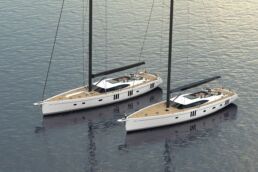
Oyster 895 and 835
Do you think the new luxury appeal of sailing yachts will convert even more people into being sailors?
This is something we talk about all the time – if someone today wants to get into boating, and they reach the level to buy a motor boat or an Oyster, or indeed another sailing yacht, what makes them choose between motor yacht vs sailboat? I think what it boils down to is that people look at motor vessels and recognise that there is less skill involved comparatively to operate them. It’s much more similar to driving a car, something which many adults already know how to do. However, with sailing, people often say it’s a completely different language, and you certainly have to learn some new skills. You can’t just get on and know how to sail, you need to do some training. I think this is probably the main thing that pushes people towards motor boats, though maybe sailing yachts also have a rough-and-ready perception, whereas motor boats seem sexier, faster and relaxed. Either way though, our sailing yachts are both super luxurious and have the option to be crewed, meaning that you don’t always have to know a whole lot about sailing before you set off on your first adventure. Whilst our smaller boats can accommodate just one crew member, our bigger models – so the Oyster 675, 745, 885 and the 1225 – all have room for a full professional crew onboard. This means sailing can be just as relaxed as for an owner and their guests on a motor yacht, but with the opportunity to learn more as you go along and escape to more exciting unexplored destinations.
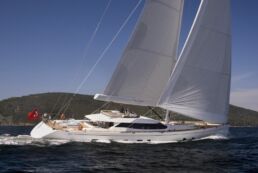
Oyster 125 TWILIGHT
What about sailing’s appeal as a more eco-friendly way of boating?
As sailors we get to explore the farthest corners of the earth, experiencing incredible natural beauty every day. We have the ocean to thank for being able to reach these locations, and it is only right that we protect our seas and the surrounding environment as much as possible. Sailing already has the advantage of being more environmentally-friendly than motor boating: we don’t need to have the motor running at all times to get where we need to go. However, we try to go beyond the normal power vs sail advantages. At Oyster we are currently in the process of making our owner regattas greener, working with the Sailors for the Seas Clean Regattas programme to ensure our sailing events are sustainable. We are also always looking out for further opportunities to make our luxury sailing yachts more eco-friendly with new power sources (e.g. hybrid).
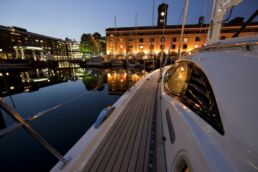
So is Oyster aiming to convert motor yacht fans to the brand?
I think we could even take people who fall firmly on the side of motor in the sailing yachts vs motor yachts debate, put them on an Oyster and they would immediately see all the incredible benefits of sailing. It is so much more relaxed, plus its quieter, doesn’t lead to big fuel bills, doesn’t mean big marina bills, offers better options for off-the-beaten-track exploration, and truly is just as luxurious. But we’re definitely also here to say that sailing is open for all and to encourage those who are new to boating to try it. It’s a brilliant sport in the way that you can buy a dinghy for £500 and get on the water, or you can buy one of our incredible Oyster yachts.
Interviewer: Colette Flowerdew-Kincaid
Learn more on oysteryachts.com
SHARING IS CARING - THANK YOU!
Raven // baltic yachts 111, 63m fury // van geest design and rob doyle design, wallywind150 and 130, base jump from sailing yacht annagine, cool breeze – brenta 80 dc by michael schmidt yachtbau, r77 with multiple rotating twin wingmast by mathis rühl, louise // claasen shipyards, swan 98 // german frers // misa poggi.
About Publisher

Using a minimum of third party cookies for YouTube, Vimeo and Analytics.
Privacy Preference Center
Privacy preferences.
Google Analytics

My Cruiser Life Magazine
Yacht vs Sailboat – A Definitive Guide
What exactly is a yacht, anyway? Does it have to be a motor boat? But what about large sailing yachts?
The term is confusing because it is used differently in different places. Sometimes, it’s a term only reserved for large motor yachts with multiple crew member teams.
Here is a look at my observations. You might find that the lines are different in your harbor, but this article should get you started.
Table of Contents
- Sailboat vs Yacht – What’s the Difference?
Six Things that Make It a Yacht
So what’s a yachtie, then, sailing yacht vs motor yacht, types of yacht — what makes it a megayacht, modern yachts, classic designs.
- What about Yacht Racing?
Sailing Yachts or Motor Yachts
Faqs – motor and sailing yachts vs sailboats.
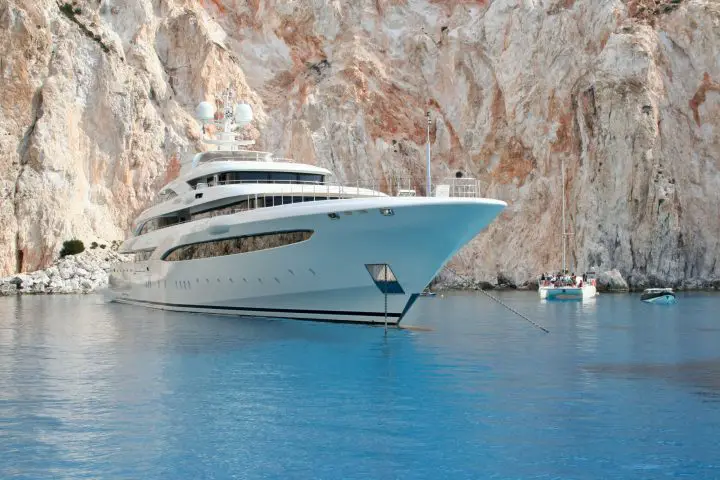
Sailboat vs Yacht – What’s the Difference?
Before diving in, it should be noted that there is some regional variation at play. For example, American and British sailors use the word yacht very differently.
First, the American definitions. From the Merriam-Webster dictionary, here are how sailboats compare to yachts.
Sailboat – A boat usually propelled by sail sailboat Boat – A small vessel for travel on water Yacht – Any of various recreational watercraft, such as a) a sailboat used for racing, or b) a large usually motor-driven craft used for pleasure cruising Merriam-Webster Dictonary
So right away, we can see a few trends that play out in the real world. For one, any term with the word “boat” is inherently generic. It could be a fishing boat, a work boat, or a pleasure boat. Likewise, it could be a sailboat or a motorboat.
On the other hand, a yacht is a special kind of boat. It is always for recreational and not commercial use. Sometimes it’s a sailboat used for racing, and sometimes a motorboat used for cruising.
From my personal experience on the water, I don’t disagree with this definition, but it leaves out a lot of nuances.
Across the Pond, the use of the word yacht is slightly different. In British usage, the words “yacht” and “sailboat” are used more or less interchangeably, with more sailors tending toward the word yacht. Here’s the definition according to the Cambridge English Dictionary.
Yacht – a boat with sails and sometimes an engine, used for either racing or traveling on for pleasure Cambridge English Dictionary
This sounds like the definition of a sailboat by US usage to my ear. But this is precisely how many Brits I have met in my travels refer to their boats—er, yachts.
Besides the dictionary definitions, we could look at how the term is used in the publishing world. For example, one of the most popular UK-based magazines is Yachting World . The magazine covers cruising boats, global sailing destinations, around the world races, and general sailing techniques. Its nearest US competitor is called Cruising World.
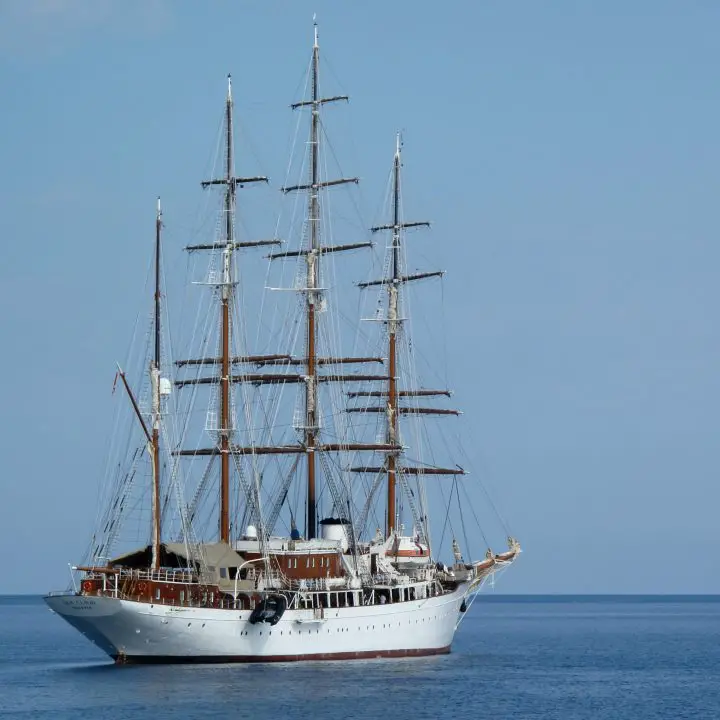
As a boater in South Florida, I became more aware of the differences between a boat and a yacht. You cannot navigate the waters between Fort Lauderdale, Palm Beach, and Miami for long without noticing a few other things that will qualify you as a yacht.
1. Yachts are nearly always operated by a professional crew who act as hosts for the owners and guests. There’s always a captain and chef, and usually stewards and deck hands too.
2. Yachts are flashy—they look expensive, and they are expensive. They shine, they’re always washed, and their wood and stainless glisten with perfection. After all, they have a full-time crew to tend to all of that.
3. While motor yachts are more common, there are plenty of beautiful sailing yachts on the water as well.
4. Yachts tend to be big. They need to be big enough for guests and crew to be comfortable. Plus, many are owned by business owners who use them to entertain.
5. Yachts spend much of their time with no guests/owners on board. Instead, the crew moves the yacht from one place to another, and the owner flies in to enjoy a few days a month onboard.
6. Many yachts are available for charter. While one person might own it and use it, they don’t spend all their time onboard. So when it’s still idle, it and its crew are leased out for days/weeks/months at a time.
Even within the subset of the motor yachts, there is significant variation and room for definition. To illustrate, some boats are designed to be sleek and modern, with the stately look of a yacht.
The term yachtie is commonly heard in port cities around the world as a person who gets off a yacht. Initially, this term was used only for wealthy owners or their guests. However, if you’re in a place where “yacht” means smaller boats, then any sailboat owner could be called a “yachtie.”
Nowadays, though, the term yachtie also could refer to the crew. Bravo TV’s Below Decks reality series focuses on the adventures and misadventures of the crews on these sorts of yachts.
More often than not, yachts are motorboats. But they aren’t just any motorboat. They are often sleek and fast ones that look like they just blasted out of the newest James Bond film.
There are also plenty of other styles of yacht on the ocean. Yachts take many shapes and forms since the best naval architects design them to suit whatever their clients want to do.
For example, some yacht owners use their boats to explore the Seven Seas. To do this, they might commission a custom expedition yacht or convert an old research vessel, fishing boat, or tugboat. These vessels are great for getting off the beaten track and taking any long trip.
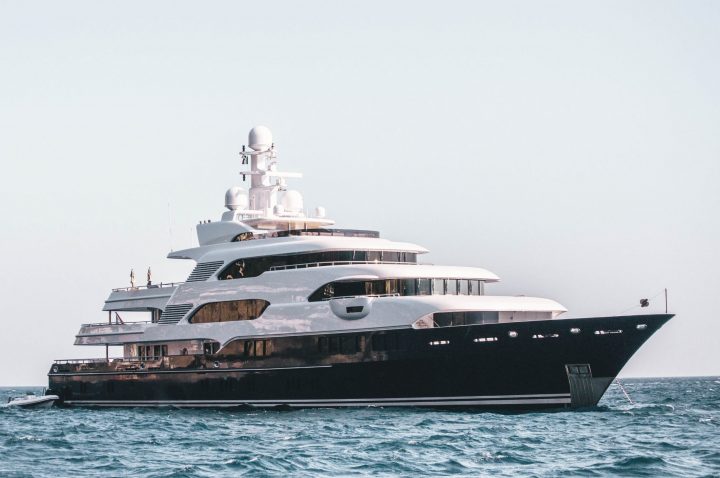
And similarly, some yacht owners want to sail. Some enjoy sailing for sailing’s sake, and others want their floating mansions to produce a smaller environmental impact by cutting down on their use of fossil fuels.
There are classic sailboat superyachts, like the three-masted schooner EOS . The EOS is the second-largest pure sailing yacht in the world at 305 feet (95 meters) long. She was launched in 2007 and is owned by movie billionaire Barry Diller and his wife, fashion designer Diane von Fürstenberg.
But you can’t compare the motor yacht vs sailing yacht without mentioning some of the other ultra-modern takes on the classic sailboat. The Maltese Falcon is a well-known sailing superyacht with three masts. But unlike the conventional schooner rig found on the EOS, the 288-foot (88-meter) Maltese Falcon has DynaRig technology . It looks like a square-rigger from the 1800s, but the masts can rotate, allowing it to sail upwind.
And for those who are still pondering sailing vs motor yacht design, you can’t miss Sailing Yacht A . Sailing Yacht A is sometimes noted as the largest sailing yacht in the world, but due to its unusual design, it is actually a “sail-assisted yacht.” In other words, this boat has sails, but it needs to run the motor to make way—the sails only help the motors.
How Big Is a Yacht?
With varying meanings worldwide, no single definition for the word yacht exists. Many brokers and charter companies loosely define a yacht as being at least 80 feet (24 meters) long.
In an industry where the lowest entry-level model needs to be big, luxurious, and fancy—how do different naval architects and boat makers differentiate themselves? In other words, how can a yacht be more than just a yacht?
The answer, of course, is to be a SUPER or a MEGA yacht. There’s no agreed-upon definition of what precisely these terms entail, but make no mistake–it takes a big yacht.
Worth Avenue Yachts, a global yacht broker and charter specialist company, postulates that a superyacht is at least 78 feet long (24 meters).
Furthermore, mega yachts are even grander. They start around the 200-foot (60-meter) line and keep getting bigger from there. The largest megayacht in the world is the 592-foot (180-meter) AZZAM . AZZAM was launched by Lürssen Yachts in 2013 was built for the President of the United Arab Emirates.
Yacht Aesthetics
So we’ve touched on the fact that yachts are usually pretty big, and in some cases really, really big. But there’s another thing that sets them apart from the typical sailboat, too. Yachts look different.
Generally, there are two aesthetics or looks that yachts take on, forming something of a motor yacht debate. Of course, this isn’t an inclusive list. Many designers work to make a statement with their yachts. The look of the finished vessel is a statement and an advertisement for the builder.
There are many yachts built that are designed right from the drawing board to turn heads. The most common way they do this is by making them modern and sleek, even futuristic at times.
Designers and builders put the latest technologies into yachts to appeal to early adopters of new technologies. What CEO or celebrity doesn’t want to own the world’s fastest yacht ?
And then there are futuristic-looking ones with forward-thinking designs. Boat International collected some of the craziest-looking yachts that are worth a look.
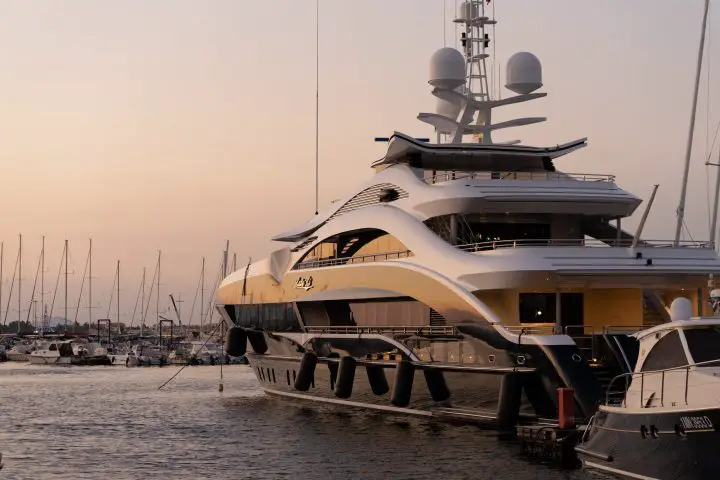
The yachts above get their title as yachts thanks to their value and size. But there’s another classification that you should consider—those yachts that get their name for their air of traditionalism.
Perhaps they are well-cared for or restored wooden hulled yachts from the 1920s or 30s. Many of these classics are sailing yachts , but that isn’t always the case.
In some cases, they are modern fiberglass or metal-hulled boats built recently and designed by contemporary designers. But their owners wanted that classic yacht aesthetic, so they created something that appears older than it is. Here’s a look at some of the nicest classic yachts out there.
What about Yacht Racing?
The older, more traditional British use of the word yacht seeps into everyday American English in a few places.
They’re more common on the international stage, so beyond the everyday use of yacht terms in the US, these particular uses harness a more global view of the word.
One such example is in the term yacht racing. Yacht racing sounds fancy, and it usually is, but it is entirely about sailboats. Yacht racing is usually done at a yacht club, another term that focuses on an older use of the word.
In the heydays of the yacht club, the line between the sort of crewed megayachts you see today and the person sailboat was blurrier. Fewer people had boats, and those boats that the wealthy could afford were divided between large crewed vessels and those small private boats kept at clubs. And, of course, one of the favorite activities at the yacht clubs was yacht racing.
Yacht clubs are still a thing, but they are less a part of everyday boating in the US than they used to be. Yacht clubs range from a local, passionate small boat sailing community to exclusive, elite social clubs with little to do with yachts.
Yacht racing is an international sport, although even the Olympics refer to it now as “sailing.” The oldest trophy in sports is the America’s Cup , and the competition for it is the pinnacle event in yacht racing.
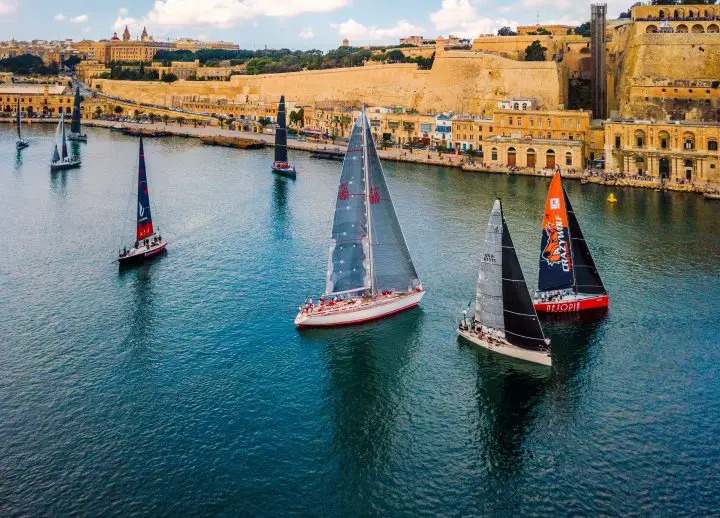
So how do you tell a yacht from other boats? It depends on several factors, but unlike a lot of things in boating, there really isn’t a right or wrong answer. If you want to call your new 20-foot pontoon a yacht or even a ship, go right ahead. However you want to enjoy life, the weather, sun, wind, or adventure, only one thing is for sure. Owning a boat makes it better!
To learn more about other boats and their comparisons, check out: Catamaran vs Pontoon
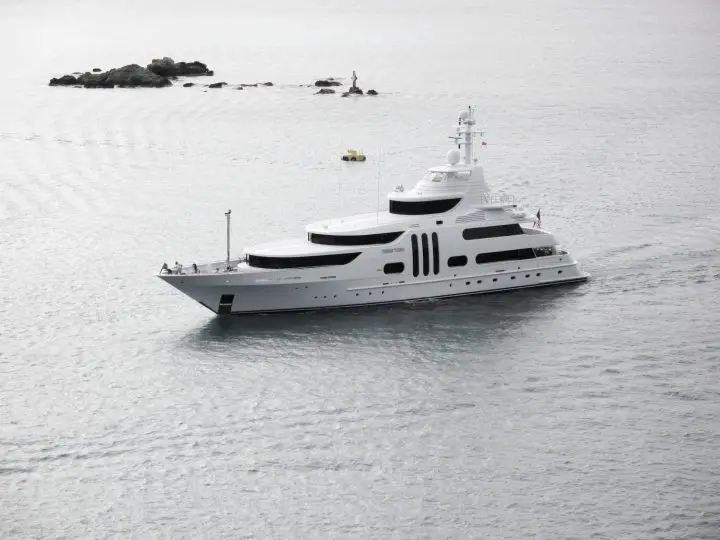
At what point does a sailboat become a yacht?
There is no definitive line where a sailing boat can be called a yacht. To some extent, you can use the word sailboat to describe any private, recreational sailing vessel. This is how the word is used in many parts of the world.
In the United States, the word yacht is usually reserved for crewed luxury vessels. To count as a yacht by this definition, the boat would need to be very high-end, sleek, and expensive. In short, it’s probably not a yacht if it’s under about 80 feet or so.
Are yachts or sailboats more expensive?
Yachts are more expensive, but it’s all in the definition of the word. In the US, the understood definition of a yacht is a luxurious sailboat or motor yacht. More often than not, yachts are big enough to require a professional crew.
On the other hand, a sailboat is any vessel that uses sails for power. So a yacht could be a sailboat, but not all sailboats are yachts. By the US definition, most sailboats are small and far from the lavish luxury you’d find on a yacht. But in some parts of the world, “yacht” is used interchangeably for a sailboat of any value.
Is a 40 foot sailboat a yacht?
The answer depends on where you are from. In parts of the world heavily influenced by British English tradition, the word yacht is often interchangeable with sailboat. If this sounds right, then a 40-foot sailboat could definitely be a yacht.
But in the US, the word yacht is usually reserved for large, lavish, and expensive vessels with professional crews—the types owned by celebrities and the super-wealthy. If this sounds more like your neighborhood, chances are a 40-foot sailboat is just a sailboat. On the other hand, if it doubles or triples in size and gets a crew, it might be bordering on yacht territory.
Is a sailing yacht cheaper than a yacht?
In general, the purchase price of yachts are roughly equal. While sailboats have more rigging and equipment, motor yachts have larger engines, so the prices are closer than you might imagine. There are too many variables to generalize when it comes to operating costs. In general, though, a fast-moving powerboat will always cost more than a slow-moving sailboat due simply to fuel costs.
If you’re thinking about chartering and want to compare the prices of sail versus power, companies like The Moorings Charters allow you to browse various destinations and boats. For example, a one-week charter on a 42-foot sail catamaran in the BVI starts at around $9,400. For comparison, that same charter on their smallest power catamaran, a 43 footer, starts at $11,070.
Matt has been boating around Florida for over 25 years in everything from small powerboats to large cruising catamarans. He currently lives aboard a 38-foot Cabo Rico sailboat with his wife Lucy and adventure dog Chelsea. Together, they cruise between winters in The Bahamas and summers in the Chesapeake Bay.

Motorboat vs. Sailboat Charter: Which is the best for you?
- July 18, 2019
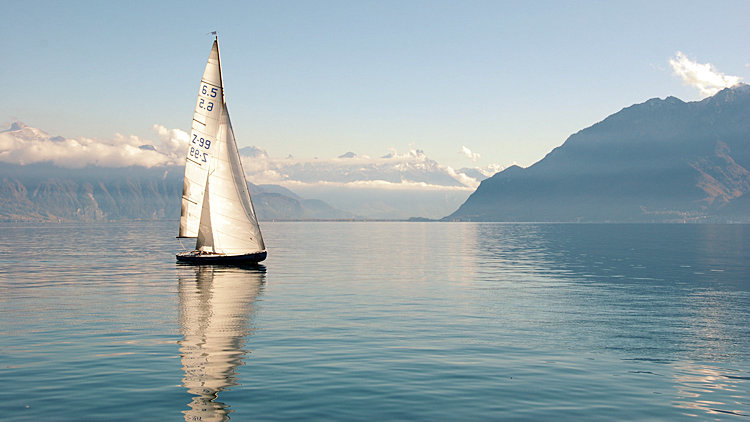
A yachting holiday can be adventurous, relaxing, inspiring, and many other things. If you’re planning a yachting vacation for this summer, one of the first things you will have to decide will be the type of boat you want, if you don’t already own one. You will have to choose between a motor yacht charter and a sailing boat, and your decision will depend on a number of factors. Your destination, the number of people who will be traveling, and the kind of experience you want to have will all help you decide on which kind of boat to head out to sea.
A sailboat will take you on an adventurous, romantic journey where you will connect with the sea and the elements. Unless you opt for a fully crewed charter, you will also learn the basics of sailing and handling the ropes, the sails and the terminology. Motor yachts offer speed, excitement and all kinds of possibilities for onboard entertainment. Sailing trips offer different unique experiences, and you can choose which one is right for you this summer.
Bring the Party With You on a Motor Yacht
Motor boat yachts are descended from sailing yachts but with one big difference. They are powered by engines rather than sails, which makes you independent of weather conditions. Their powerful engines make them very stable, and give you the speed and freedom to chart your own route.
Because of their design, which has a shallower draft, motor yachts can navigate shallow coastal waters. This makes them the ideal craft for island hopping, whether it’s the Caribbean or the Aegean Sea. These roomy craft also have facilities like bars, jacuzzis, and even dance floors and bars swimming pools. There’s plenty of space for parties, fundraisers and larger groups.
Motor yachts generally have larger cabins and more room. Cost is another factor in deciding between a motor yacht or a sailing boat, and motor yacht charters can be very reasonably priced. Keep in mind however that fuel costs will tend to run high.
If speed in getting to your destination is a consideration, motor yachts are the better choice. If however you want to travel the seas powered by the wind, a sailing boat is right for you.
Sailboat Charters Take You Anywhere You Want to Go
A sailboat charter is the perfect getaway, because it is a little floating world of its own. If you’re new to sailing, you’ll be glad to hear that sailboats are also very stable. There are many different types of sailboats, based on their design and size.
Typical charter sailboats will have anywhere from one to six cabins, located on the lower deck. There’s usually also a saloon, which can be a dining room and common area. It can also be used for extra sleeping space at night.
Sailboats generally have fewer people on board than motor yachts, and they can do longer trips. In fact, they can take you to all kinds of exotic destinations, from the Mediterranean to Tahiti and points between. You can even circumnavigate the globe.
Sailboat charters are a great idea for a family vacation. There’s less room on a sailboat than a motor yacht, and more shared spaces. Keep in mind that life onboard in close quarters can produce its own stresses, and chose your travel companions and their cabin allotments carefully.
Different Types of Sailboat Charters
Depending on your sailing experience and the level of comfort you’re looking for on your yachting holiday, several different types of sailing boat charters are available. You can pick a bareboat charter without a crew, or a skippered yacht charter where you get a boat and a skipper, or a fully crewed yacht.
Bareboat charters are suitable if you or a member of your party is a licensed skipper with all the requisite certificates, permits and documents. That’s because you will be sailing on your own, so it’s necessary to have someone who knows what they’re doing and can guide others. The yacht will come fully equipped with a reservoir of fuel, ropes, life jackets and other necessities. There may also be extras like a generator, air-conditioning, coffee machine, ice maker etc.
Bareboat charters are best for sailing in waters which have easy access to anchorage in case of rough weather, like the most of Mediterranean coast along Croatia, Greece, Italy and Spain.
A skippered yacht will give you a boat and an experienced skipper who will steer, help you select the route, and ensure the safety of the boat and all on board. Skippers also typically know a lot about various sailing destinations and can act as informal tourist guides. They may also share tips about sailing. If you’re heading for destinations like the North Sea, the Atlantic and the Caribbean, where the going can be rough at times, it’s best to charter a skippered yacht.
A fully crewed yacht charter comes with a skipper and crew as well as the boat. This is the luxury option, where the crew will not only sail and navigate but also provide your meals and drinks.
Motor boat yachts and sailboats offer unique and different experiences, and both have their supporters. Once you decide which one is right for you, the next step is to plan your route. Bon voyage!
Sign-up for Our Email Newsletter
Find a luxury hotel & book with exclusive perks.

- Luxury Partners
Villa Lala — Romantic Boutique Hotel in Puerto Vallarta

Cabo Platinum - Cabo San Lucas Luxury Villas, Yachts & Concierge Services

Villa Firenze - Costa Rica Luxury Villa Rental

JUP - Personal Service for Buying and Selling Real Estate in Jupiter, Florida

Polaris Slingshot - A three-wheeled sensation that re-ignites your love for driving

Rancho Valencia Resort & Spa - Rancho Santa Fe, California - One of the West’s most sought-after five star resorts

Tuscan Dream - Immerse Yourself in the Tuscan Villa Vacation Experience

Grand Hotel Portovenere - Cinque Terre - Discover this beautiful region of Italy!

Dude Ranchers Association - An all-inclusive vacation experience like no other

El Encanto, A Belmond Hotel - Santa Barbara, California - Experience timeless Californian glamor.

Grand Hyatt Kauai Resort & Spa - Poipu, Kauai, Hawaii - Beachfront Resort

Culture, Spirituality, and Wellness in Japan's Tochigi Prefecture

Blue Waters Resort & Spa - Antigua - A hidden gem nestled in a private bay on Antigua's northwestern coast with sunset views

A.M.A Selections - Luxury Villa Rentals throughout Europe

Live Aqua Beach Resort Cancun, Mexico - Adults Only, All Inclusive

Argentario Golf & Wellness Resort - Porto Ercole, Tuscany, Italy

Porto Zante Villas & Spa - Zakynthos, Greece - The leading villa resort in Europe
Boat Reviews
- Aquila Boat Reviews
- Aspen Boat Reviews
- Avalon Boat Reviews
- Aviara Boat Reviews
- Axopar Boat Reviews
- Barletta Boat Reviews
- Bayliner Boat Reviews
- Centurion Boat Reviews
- Charger Boat Reviews
- Cruiser Yachts Reviews
- Formula Boat Reviews
- Fountaine Pajot Reviews
- Freeman Boatworks Reviews
- Galeon Luxury Yachts Reviews
- Intrepid Boat Reviews
- Jupiter Marine Reviews
- Manitou Boat Reviews
- Native Watercraft Reviews
- Phenom Yacht Reviews
- Pursuit Boat Reviews
- Sailfish Boat Reviews
- Sea Ray Boat Reviews
- Sea-Doo Watercraft Reviews
- SeaVee Boat Reviews
- Solace Boat Reviews
- Windy Boat Reviews
- X Shore Boat Reviews
- Yamaha Boat Reviews
- Boats Specs
- Marine Pros
- Boat Insurance
- Boat Warranties
- Boat Transport
- Boat Towing
- Marine Forecasts

Your Ultimate Boating Resource

2024 Pursuit OS 445: An Overview
Boat safety 101: exploring the serenity and adventure of boating, the moment of truth – 6 signs you need a new boat, is it possible to wakesurf on a pontoon boat, 2024 aquila 47 molokai review, 2024 sea-doo switch 13 sport review, 2024 aspen c120 review, the pros and cons of owning a sailboat.
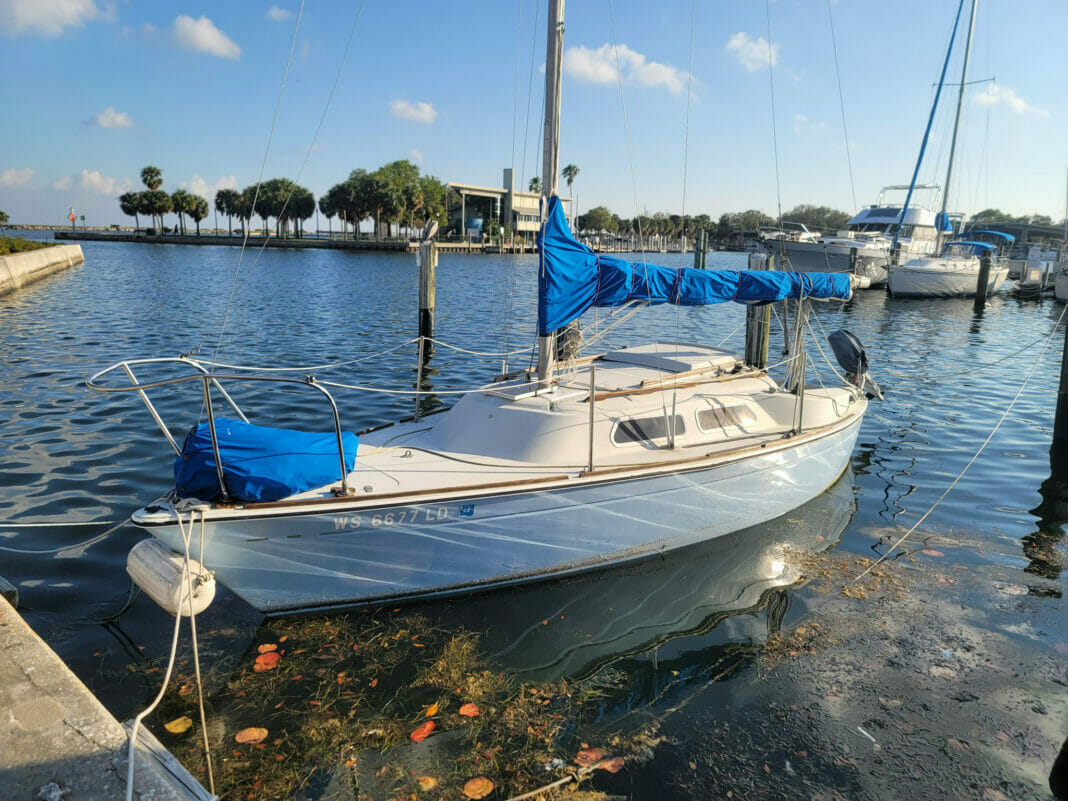
Sailing is an age-old tradition that has captivated the dreams of many. From traversing the seven seas to embarking on a weekend adventure, owning a sailboat can be an incredibly rewarding experience. But before investing in one, it’s important to understand the pros and cons of sailboat ownership.
Pros of Owning a Sailboat
First, let’s look at the main advantages of owning a sailboat.
Most modern sailboats have small motors for docking and maneuvering in close quarters. However, the main mode of locomotion remains the traditional sails, which provide a unique experience as you ride the wind to your destination. Plus, you’ll learn a new set of skills that can be used throughout your lifetime.
The freedom
Owning a sailboat gives you your own piece of sea-faring freedom. You can go wherever you want, whenever you want! No more waiting around for someone else to take you out on their boat, and forget expensive airfare to get to an exotic destination. With your sailboat, you can explore places that aren’t even accessible by land.
Maintenance
Compared to owning a motorized boat, sailboats require much less maintenance. Parts and repairs are much cheaper, and the motor requires less upkeep. You’ll also save on gas since you won’t need to refuel as often.
Doubles as a living quarter
You don’t often hear of people living on speedboats, but people do live on sailboats. For those wanting to get away from the rat race, a sailboat can be an excellent alternative to traditional living quarters.
Environmentally-friendly
Finally, sailboats are very environmentally friendly. For one, they don’t make a ruckus like motorboats. Motor noise can harm and disturb wildlife, but your sailboat won’t have that problem. Also, sailboats use the wind as their main energy source instead of fuels like gasoline and diesel.
Cons of Owning a Sailboat
The main disadvantages of owning a sailboat are as follows:
Weather dependence
Sailboats rely heavily on the wind and weather conditions for power. If there’s no wind, you won’t be able to use your sails and will have to resort to a motorized backup. Doing so might mean breaking the peace and tranquility of your journey.
Slow speeds
While it is technically possible to traverse the ocean on a big enough sailboat, the fact of the matter is that most sailboats are quite slow. A motorized boat might be a better fit if you’re looking for faster speeds and more power.
Smaller size
If you’re planning on throwing lavish parties or carrying a lot of cargo, then you’re going to need a bigger boat. Most sailboats are small compared to motorboats, so they won’t be ideal if you have larger needs.
Learning curve
Sailing requires a certain level of skill and knowledge, which can take some time to master. If you’re completely new to sailing, renting a sailboat before investing in one might be wiser. You’ll quite literally learn the ropes before diving in.
Owning a sailboat can be a gratifying experience. But just like any major purchase, it’s crucial to weigh the pros and cons before making a decision. Think about what your needs are, consider all of the available options, and make sure you’re ready for all that comes with sailing.
Happy travels!
RELATED ARTICLES
Eco-savvy sailing: expert tips for reducing fuel costs and enhancing your boating experience, sea safety blueprint: constructing the perfect float plan for your boating adventures, latest posts, the top 9 reasons to maintain a meticulous boat log, don't miss, our newsletter.
Get the latest boating tips, fishing resources and featured products in your email from BoatingWorld.com!
What type of wood is used for pier pilings?
What is the difference between a dock and a floating pier, what is the proper technique for pulling a beginner wakeboarder, what does ‘no wake’ mean on a lake, what is the difference between wash and wake, 10 essential tips for fishing near private property, the benefits of using a drift sock: guidance for anglers, lure fishing: secrets for imitating live bait and attracting fish, explore the untapped depths of america’s best bass fishing spots, tackle your catch-and-release adventures with these 6 tips, outboard motor maintenance: tips for keeping your engine in top shape, the essential boat tool kit: tools every boater needs, diy boat building: 8 tips and tricks for building your own vessel, the art of miniature maritime craftsmanship: ship in a bottle, antifouling paints: a guide to keeping your boat shipshape, beginner’s guide to standup paddle boarding: tips and techniques, boating for fitness: how to stay active on the water, kayak safety: how to stay safe on the water, anchoring in a kayak or canoe: how to secure your small boat, 2024 yamaha 222xd review, 2024 sailfish 316 dc review, 2023 seavee 340z review, 2023 centurion fi23 review, gear reviews, megabass oneten max lbo jerkbait review, fortress anchors fx-7 anchoring system review, fortress anchors fx-11 anchoring system review, fortress anchors commando anchor kit review, fortress anchors aluminum anchors review, stay in touch.
To be updated with all the latest news, offers and special announcements.
- Privacy Policy
Six presumed dead after cargo ship crash levels Baltimore bridge
BALTIMORE — A major Baltimore bridge collapsed like a house of cards early Tuesday after it was struck by a container ship, sending six people to their deaths in the dark waters below, and closing one of the country’s busiest ports.
By nightfall, the desperate search for six people who were working on the bridge and vanished when it fell apart had become a grim search for bodies.
“We do not believe that we’re going to find any of these individuals still alive,” Coast Guard Rear Admiral Shannon N. Gilreath said.
Jeffrey Pritzker, executive vice president of Brawner Builders, said earlier that one of his workers had survived. He did not release their names.
Up until then, Maryland Gov. Wes Moore had held out hope that the missing people might be found even as law enforcement warned that the frigid water and the fact that there had been no sign of them since 1:30 a.m. when the ship struck Francis Scott Key Bridge.
Moore expressed heartbreak after officials suspended the search for survivors.
"Our heart goes out to the families," he said. "I can’t imagine how painful today has been for these families, how painful these hours have been have been for these families."
It was a crushing blow to the loved ones of the missing men, who had waited for hours at a Royal Farms convenience store near the entrance of the bridge for word of their fate.
Follow live updates on the Baltimore bridge collapse
The tragic chain of events began early Tuesday when the cargo ship Dali notified authorities that it had lost power and issued a mayday moments before the 984-foot vessel slammed into a bridge support at a speed of 8 knots, which is about 9 mph.
Moore declared a state of emergency while rescue crews using sonar detected at least five vehicles in the frigid 50-foot-deep water: three passenger cars, a cement truck and another vehicle of some kind. Authorities do not believe anyone was inside the vehicles.
Investigators quickly concluded that it was an accident and not an act of terrorism.
Ship was involved in another collision
Earlier, two people were rescued from the water, Baltimore Fire Chief James Wallace said. One was in good condition and refused treatment, he said. The other was seriously injured and was being treated in a trauma center.
Moore said other drivers might have been in the water had it not been for those who, upon hearing the mayday, blocked off the bridge and kept other vehicles from crossing.
“These people are heroes,” Moore said. “They saved lives.”
Nearly eight years ago, the Dali was involved in an accident. In July 2016, it struck a quay at the Port of Antwerp-Bruges in Belgium, damaging the quay.
The nautical commission investigated the accident, but the details of the inquiry were not immediately clear Tuesday.
The Dali is operated and managed by Synergy Group. In a statement, the company said that two port pilots were at the helm during Tuesday's crash and that all 22 crew members onboard were accounted for.
The Dali was chartered by the Danish shipping giant Maersk, which said it would have no choice but to send its ships to other nearby ports with the Port of Baltimore closed.
The bridge, which is about a mile and a half long and carries Interstate 695 over the Patapsco River southeast of Baltimore, was "fully up to code," Moore said.
National Transportation Safety Board Chairwoman Jennifer Homendy said that her agency will lead the investigation and that a data recorder on the ship could provide more information.
"But right now we're focusing on the people, on the families," she said. "The rest can wait."
President Joe Biden vowed to rebuild the bridge and send federal funds.
"This is going to take some time," the president warned. "The people of Baltimore can count on us though to stick with them, at every step of the way, till the port is reopened and the bridge is rebuilt."
Speaking in Baltimore, Transportation Secretary Pete Buttigieg echoed the president's promise.
"This is no ordinary bridge," he said. "This is one of the cathedrals of American infrastructure."
But Buttigieg warned that replacing the bridge and reopening the port will take time and money and that it could affect supply chains.
The Port of Baltimore, the 11th largest in the U.S., is the busiest port for car imports and exports, handling more than 750,000 vehicles in 2023 alone, according to data from the Maryland Port Administration.
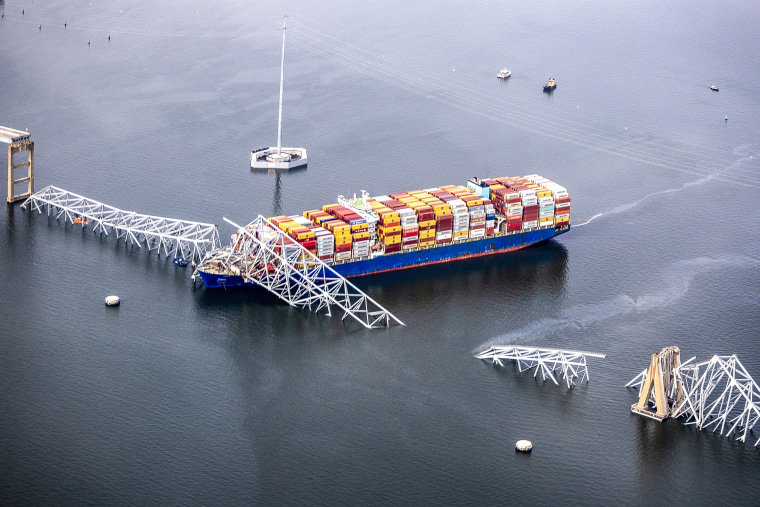
Writer David Simon, a champion of Baltimore who set his TV crime drama "The Wire" on the streets of the city he once covered as a reporter, warned online that the people who will suffer the most are those whose livelihoods depend on the port.
"Thinking first of the people on the bridge," Simon posted on X . "But the mind wanders to a port city strangling. All the people who rely on ships in and out."
Timeline of crash
Dramatic video captured the moment at 1:28 a.m. Tuesday when the Dali struck a support and sent the bridge tumbling into the water. A livestream showed cars and trucks on the bridge just before the strike. The ship did not sink, and its lights remained on.
Investigators said in a timeline that the Dali's lights suddenly shut off four minutes earlier before they came back on and that then, at 1:25 a.m. dark black smoke began billowing from the ship's chimney.
A minute later, at 1:26 a.m., the ship appeared to turn. And in the minutes before it slammed into the support, the lights flickered again.
Maryland Transportation Secretary Paul Wiedefeld said the workers on the bridge were repairing concrete ducts when the ship crashed into the structure.
At least seven workers were pouring concrete to fix potholes on the roadway on the bridge directly above where the ship hit, said James Krutzfeldt, a foreman.
Earlier, the Coast Guard said it had received a report that a “motor vessel made impact with the bridge” and confirmed it was the Dali, a containership sailing under a Singaporean flag that was heading for Sri Lanka.
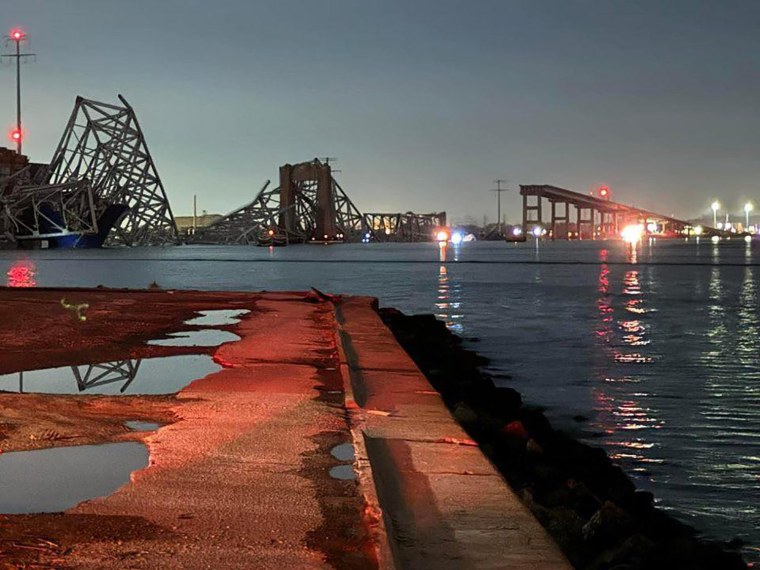
Bobby Haines, who lives in Dundalk in Baltimore County, said he felt the impact of the bridge collapse from his house nearby.
"I woke up at 1:30 this morning and my house shook, and I was freaking out," he said. "I thought it was an earthquake, and to find out it was a bridge is really, really scary."
Families of bridge workers wait for updates
Earlier in the day, relatives of the construction crew waited for updates on their loved ones.
Marian Del Carmen Castellon told Telemundo her husband, Miguel Luna, 49, was working on the bridge.
“They only tell us that we have to wait and that they can’t give us information,” she said.
Castellon said she was "devastated, devastated because our heart is broken, because we don’t know how they have been rescued yet. We are just waiting for the news."
Luna's co-worker Jesús Campos said he felt crushed, too.
“It hurts my heart to see what is happening. We are human beings, and they are my folks,” he said.
Campos told The Baltimore Banner that the missing men are from El Salvador, Guatemala, Honduras and Mexico.
Active search and rescue ends
The Coast Guard said it was suspending the active search-and-rescue effort at 7:30 p.m. Tuesday.
"Coast Guard’s not going away, none of our partners are going away, but we’re just going to transition into a different phase," Gilreath said at a news conference.
Maryland State Police Superintendent Roland L. Butler, Jr., said it was moving to a recovery operation. Changing conditions have made it dangerous for divers, he said.
Butler pledged to "do our very best to recover those six missing people," but the conditions are difficult.
"If we look at how challenging it is at a simple motor vehicle crash to extract an individual, I'm sure we can all imagine how much harder it is to do it in inclement weather, when it's cold, under the water, with very limited to no visibility," he said.
"There's a tremendous amount of debris in the water," which can include sharp metal and other hazards, and that could take time, Butler said.
'A long road in front of us'
Built in 1977 and referred to locally as the Key Bridge, the structure was later named after the author of the American national anthem.
The bridge is more than 8,500 feet long, or 1.6 miles. Its main section spans 1,200 feet, and it was one of the longest continuous truss bridges in the world upon its completion, according to the National Steel Bridge Alliance .
About 31,000 vehicles a day use the bridge, which equals 11.3 million vehicles per year, according to the Maryland Transportation Authority.
The river and the Port of Baltimore are both key to the shipping industry on the East Coast, generating more than $3.3 billion a year and directly employing more than 15,000 people.
Asked what people in Baltimore can expect going forward, the state's transportation secretary said it is too early to tell.
"Obviously we reached out to a number of engineering companies, so obviously we have a long road in front of us," Wiedefeld said.
Julia Jester reported from Baltimore, Patrick Smith from London, Corky Siemaszko from New York and Phil Helsel from Los Angeles.
Julia Jester is a producer for NBC News based in Washington, D.C.
Patrick Smith is a London-based editor and reporter for NBC News Digital.
Phil Helsel is a reporter for NBC News.
Corky Siemaszko is a senior reporter for NBC News Digital.
Here's who could be responsible for paying for the Baltimore bridge disaster
- The Francis Scott Key Bridge in Baltimore collapsed after a container ship collided with it.
- Several entities could be on the hook to foot the bill in the aftermath of the disaster.
- The maritime insurance industry will likely be saddled with the highest costs.

The Francis Scott Key Bridge in Baltimore collapsed on Tuesday after a large container ship ran into it, leading to six presumed deaths and millions of dollars in possible damage.
It's still too early to estimate the total economic impact of the disaster, but between the cost of rebuilding the decades-old bridge, compensating the victims' families , and paying out damages for disruptions to the supply chain, the eventual cost of the disaster is expected to be significant.
Who will pay to rebuild the bridge?
President Joe Biden said on Tuesday the federal government should be responsible for paying to reconstruct the damaged Francis Scott Key Bridge.
"It is my intention that the federal government will pay for the entire cost of reconstructing that bridge, and I expect Congress to support my effort," Biden said.
The bridge was built in the 1970s for about $60 million, but the cost of rebuilding it could be 10 times its original price tag, an engineering expert told Sky News.
Baltimore is among the busiest ports in the nation , with more than a million shipping containers passing through each year. The collapse — which closed the port to all maritime and most road traffic until further notice — is already beginning to wreak havoc on the supply chain.
The cost of building the bridge back fast enough to offset diversions as much as possible could saddle the government with a more than $600 million bill, David MacKenzie, the chair of the engineering and architecture consultancy COWIfonden, told Sky News.
Who will pay for damages to the ship and its cargo?
The container ship, the Dali , is owned by a Singapore-based firm. The ship's charterer, Maersk, confirmed to Business Insider that vessel company Synergy Group operates the ship.
However, the companies with cargo aboard the Dali could ultimately be responsible for some of the ship's damages and cargo costs, according to Ryan Petersen , the CEO of the supply-chain-logistics company Flexport, which had two containers on the ship.
Related stories
The Dali was carrying 330 containers that must now be rerouted, Petersen said in an X thread.
An ancient maritime law known as " general average " dictates that companies with even a single container aboard a ship split certain damages pro rata based on the number of containers they had on board, ensuring all the stakeholders benefiting from the voyage are splitting the risk, Petersen said.
General average situations can occur when a ship is stranded or when cargo is damaged or thrown overboard to save the vessel, according to Flexport . The concept helps ensure that all parties who have a vested interest in the vessel share the cost and concern of protecting it.
It's too soon to know whether damages incurred to free the Dali in the coming days will qualify as a case of general average.
Who will pay for everything else?
The majority of the financial fallout is likely to lay primarily with the insurance industry, according to media reports.
Industry experts told the Financial Times that insurers could pay out losses for bridge damage, port disruption, and any loss of life.
The collapse could drive "one of the largest claims ever to hit the marine (re)insurance market," John Miklus, the president of the American Institute of Marine Underwriters, told Insurance Business.
He told the outlet that the loss of revenue from tolls while the bridge is being rebuilt will be expensive, as will any liability claims from deaths or injuries.
The Dali is covered by the Britannia Steam Ship Insurance Association Ltd., known as Britannia P&I Club, according to S&P Global Market Intelligence.
In a statement to Business Insider, Britannia said it was "working closely with the ship manager and relevant authorities to establish the facts and to help ensure that this situation is dealt with quickly and professionally."
Britannia is one of 12 mutual insurers included in the International Group of P&I Clubs, which maintains more than $3 billion of reinsurance cover, sources familiar with the matter told Insurance Business.
Britannia itself is liable for the first $10 million in damages, both FT and Insurance Business reported. Whatever remains is dealt with by the wider mutual insurance group and Lloyd's of London, a reinsurance market in the UK, the FT reported.
Update: March 28, 2024 — This story has been updated to include additional information about general average and clarify that it is too soon to know whether general average will apply in the case of the Dali.
Watch: The container ship that destroyed the Francis Scott Key Bridge has crashed before
- Main content

IMAGES
COMMENTS
Sailing doesn't do any damage to the environment, as long as you stay off reefs and don't allow trash to fall into the water. Motor usage is minimal, so you don't contribute to the world's fuel consumption as much. Many sailors pride themselves on being able to sail their boat without using the motor at all, even when it comes to docking.
Cost. You can buy a well-kept used sailboat is between $15,000- $40,000 and a new boat you have buy for $80,000 to $150,000 depending on the type of the sailboat. You must also account for regular maintenance, insurance, docking fees, and more. The average cost of a new motorsailer is around $500K.
Pros. Speed. If you have the need for speed, then a powerboat is the right choice for you. Sailboats will never compete with the speed of the dual engines of a powerboat. Most sailboats tap out at 7 knots, but power boats typically travel at speeds of around 15 to 20 knots on a calm day. Space.
Pros and cons of motorboats. Motorboats are powered by a boat engine. They are much easier to operate than sailboats. All you need is a vessel licence and a good navigation system. In addition, motorboats are fast, reliable and stable on water. They offer plenty of deck space as there is no sail and rig to occupy most of the top area of the boat.
3. Sailing is Cheaper. So, besides being less noisy and smelly, a sailboat is also way less costly than a powerboat. Running a powerboat is notoriously costly, and for a good reason. You use A LOT of gas. Actually, if you have a really fast powerboat, it's about 25 gallons of fuel per hour.
I go through all the pluses and minus of sail and power boats, compare them and give you my opinion as to which is betterhttps://www.patreon.com/sailingdoodl...
Speed. For liveaboards, speed usually isn't a priority, but you should know what to expect from your purchase. Yes, powerboats are generally faster than sailboats. The average cruising speed of a sailboat is somewhere around 6 - 8 knots, while powerboats can easily go around 20 or more if you put your foot down.
Sailboat vs Motorboat Safety. Sailboat: Motorboat: Percentage of deaths: Unknown, but under 7%: 50% : Boats on the water: Value of sailboats sold in 2017: 435 million: Value of motorboats sold in 2017: 3.47 billion: Speed: Even racing boats under perfect conditions rarely achieve enough speed to hit anything hard enough to cause injury.
Sailboat vs motorboat. Simply put, a sailboat is powered primarily by the wind. It's also very common today for them to have a small engine to provide additional secondary propulsion for docking purposes. A sailboat is the choice if the boater wants to explore the world with their own hands and skills, and to connect to the elements in a way ...
When a sailboat passes a motor vessel, the latter has the right of way. However, note that if you utilize the engine on a sailboat, you are deemed as a motorboat. Although it may appear to be a bold statement, sailboats are far safer than powerboats. Because of the properties that sailing requires, sailboats are more stable than powerboats.
As the name of each type of boat implies, the biggest difference between a motorboat rental and a sailboat rental is the source of power. Sailboat rentals are generally powered by a system of sails, which can come in various shapes and sizes. Motorboat rentals come equipped with a wide range of different inboard and outboard motors.
Here are a few suggestions we have for choosing a cruising liveaboard boat: Try to find a boat that someone is actively cruising on vs. a weekend get away boat that sits at a dock most of the time. If someone is actively cruising with the vessel, you can be sure most of the main systems are running and have been properly maintained.
Romanticism and Authenticity vs Ease of Cruising. A sailing yacht caters more to the romantic notion of traditional yachtsmanship. With the feeling of the wind in your hair, salt spray on your face and sun on your skin offering a wonderfully liberating experience where unforgettable moments with family and friends are created, sailing is unquestionably a more thrilling and involved experience ...
A motor yacht, however is designed with primarily the highest levels of luxury and comfort in mind. Stabilizers work under the boat to help control any uncomfortable rocking and keep the boat as steady as possible when in anchorages. 3. Space. Generally speaking, motor yachts are known to hold more space than sailing yachts.
The main difference in building luxury sailing yachts vs motor yachts is that a motor boat doesn't generally travel that far. They tend to go up and down the South of France, off to the Caribbean where they hop around islands, and some might go off to do further exploring. But sailing is a different thing, more off the beaten track.
Sailing Yacht vs Motor Yacht. More often than not, yachts are motorboats. But they aren't just any motorboat. They are often sleek and fast ones that look like they just blasted out of the newest James Bond film. There are also plenty of other styles of yacht on the ocean. Yachts take many shapes and forms since the best naval architects ...
Motor yachts generally have larger cabins and more room. Cost is another factor in deciding between a motor yacht or a sailing boat, and motor yacht charters can be very reasonably priced. Keep in mind however that fuel costs will tend to run high. If speed in getting to your destination is a consideration, motor yachts are the better choice.
Images: 3. Motorsailor vs Sailboat. My partner and I are researching sailboats for live-aboard and cruising. He currently has a 48 ft. motor yacht that he wants to sell to buy a sailboat. The cost of diesel fuel these days makes power cruising too expensive, plus, who needs to smell the exhaust fumes! We would like to do some off-shore cruising ...
The maritime definition of a yacht is a private pleasure ship of at least 33 feet. At YachtWorld, we tend to consider anything in the 35-40-foot range (or larger) a yacht. Then again, different kinds of boats approach being that long, even some pontoon boats and walkarounds. However, an engine-powered watercraft under 30 feet is not usually ...
A boat's size and deck/below deck space are important considerations when choosing a sailboat. The boat's size will affect everything from whether you need to rent a slip to whether you can live aboard your boat. Sailboats have more hardware and a different hull design than powerboats, so they usually have less space than similar-sized powerboats.
Convertible: A boat with a flying bridge built atop the cabin, and an open cockpit aft. Cuddy Cabin: A powerboat with a relatively small cabin on its bow section. Deck Boat: A motorboat with a flat, open deck plan and without any below-decks accommodations. To create more forward deck space, most deck boats have a rather boxy shape, instead of ...
The freedom. Owning a sailboat gives you your own piece of sea-faring freedom. You can go wherever you want, whenever you want! No more waiting around for someone else to take you out on their boat, and forget expensive airfare to get to an exotic destination. With your sailboat, you can explore places that aren't even accessible by land.
As nouns the difference between motorboat and sailboat is that motorboat is (nautical) any vessel driven by an engine (either inboard or outboard), but especially a small one while sailboat is a boat propelled by sails. As a verb motorboat is (slang) to place one's head between a woman's breasts and make the sound of a motorboat with one's lips whilst moving the head from side to side.
Earlier, the Coast Guard said it had received a report that a "motor vessel made impact with the bridge" and confirmed it was the Dali, a containership sailing under a Singaporean flag that ...
President Joe Biden said on Tuesday the federal government should be responsible for paying to reconstruct the damaged Francis Scott Key Bridge. "It is my intention that the federal government ...